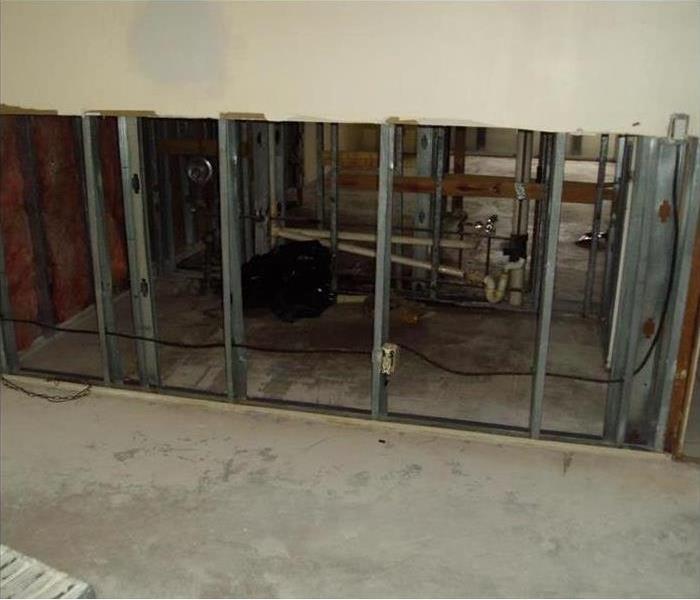Archived Water Damage Blog Posts
Protect Your Property from Water Damage in Winter Park
7/22/2024 (Permalink)
As residents of Winter Park, we cherish our picturesque surroundings and charming community. However, living here also means facing unique weather challenges that can pose serious risks to our homes and businesses. Among these, water damage stands out as a significant concern, particularly during the rainy season.
Water Damage in Winter Park: Why It Matters
Living in Winter Park means enjoying a stunning environment and a vibrant community. However, the area's climate can indeed present challenges, especially when it comes to protecting properties from water damage. SERVPRO® understands the specific risks faced by Winter Park residents and offers expert water damage restoration services tailored to our locality's needs.
Water Damage Prevention is Key
Water damage in Winter Park can be a year-round issue, whether from heavy rainfall, hurricanes, or burst pipes due to fluctuating temperatures. Preventing water damage is critical to maintaining the structural integrity and value of your property. When not addressed promptly, water intrusion can weaken foundations, foster mold growth, and disrupt your daily life.
To safeguard your home or business, routine inspections and maintenance are crucial. Start by ensuring that your gutters and downspouts are clear of debris and directed away from your foundation. Regularly check for leaks in roofs, walls, and plumbing systems. Also, consider investing in a sump pump for basements, which can help protect against flooding during heavy rains.
The Impact of Water Damage
The aftermath of water damage is often significant and can extend far beyond what is visible to the naked eye. Water can seep into hidden areas, causing wood rot, rusting metal components, and damaging electrical systems. Over time, this can compromise the safety of your building and lead to expensive repairs.
Mold growth is another serious consequence of water damage. Even a small amount of moisture can create the perfect breeding ground for mold spores, which can spread rapidly. Mold not only damages surfaces but also poses health risks to occupants, including allergies, respiratory issues, and other illnesses.
SERVPRO's comprehensive water damage restoration services in Winter Park aim to mitigate these risks effectively. Our experienced professionals use advanced equipment to detect hidden moisture, dry affected areas thoroughly, and implement preventive measures to avoid future issues.
Steps for Immediate Response
In the unfortunate event that your property suffers water damage in Winter Park, taking immediate action is essential to minimize further harm. Here are some steps you can follow:
- Safety First: Ensure that it's safe to stay in your home. Avoid electrical hazards and be cautious of slippery floors.
- Stop the Water Source: If possible, shut off the source of water to prevent more damage.
- Move Valuables: Protect your belongings by moving them to a dry, safe place.
- Call SERVPRO: Contact our emergency water damage restoration team to quickly address and mitigate the damage.
At SERVPRO, we prioritize a swift response and use state-of-the-art drying and dehumidifying equipment to restore your property efficiently. Our goal is to make the restoration process as smooth as possible, allowing you to return to normalcy quickly.
The SERVPRO Advantage
Choosing SERVPRO for water damage restoration in Winter Park means partnering with industry-leading experts committed to your satisfaction. Our certified technicians are equipped with the knowledge and tools necessary to handle any water damage scenario. From initial inspection and damage assessment to full restoration, we provide end-to-end solutions tailored to your specific needs.
We understand that dealing with water damage can be stressful, which is why we emphasize clear communication and compassionate service. We work directly with your insurance company to facilitate the claims process, ensuring a hassle-free experience for you.
Our team doesn't just focus on restoration; we also educate our clients on preventive measures to protect their properties from future water damage. By choosing SERVPRO, you’re not only resolving the immediate issue but also investing in your property's long-term health.
Act Now to Protect Your Winter Park Property
Water damage demands immediate attention and a professional touch. Don’t let water damage impair the beauty and safety of your Winter Park home or business. Contact SERVPRO today for reliable, expert water damage restoration services designed to restore your peace of mind.
Protecting Your Property, Restoring Your Peace of Mind
Ready to tackle water damage in Winter Park? Reach out to SERVPRO now for a free consultation and rapid response. Let us help you safeguard your property with our expert water damage restoration services. Don’t wait for the damage to worsen—act today to keep your Winter Park home or business safe and sound.
Water Damage Cleanup & Safety Tips
6/13/2022 (Permalink)
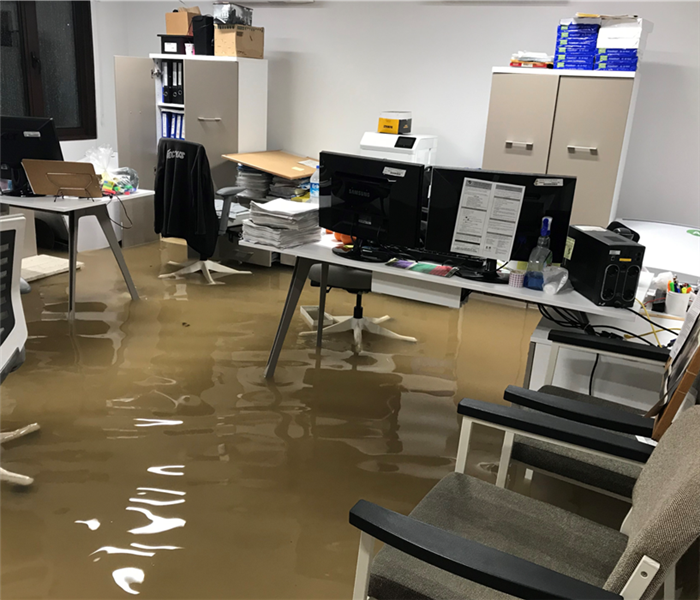 Standing water is a perfect breeding ground for bacteria and mold. Extracting this water and drying in a timely manner is essential for prevention.
Standing water is a perfect breeding ground for bacteria and mold. Extracting this water and drying in a timely manner is essential for prevention.
If a house has had a flood, ensure you confirm its safety before entering it. Check for structural damage and electrical hazards while using protective wear such as respirators, and gloves. After these, you can follow the following safety tips:
Act Fast
The seriousness of water damage rises fast as the water stays stagnant, and your house and its contents are soaked in water. Therefore, be quick on time. Molds grow in a short time, within 48 hours. To ensure you contain the flood damages, contact professionals like the SERVPRO of Winter Park to help remove and dry out the water before the molds begin to grow.
Ensure There Is Enough Circulation Of Air In The Affected Areas To Avoid Mold From Growing
Mold thrives in organic materials like particleboard or paper and moisture. To reduce or stop the damage, you can open windows and place fans in the rooms to allow air circulation and maintain average temperatures. When cleaning, work as you go towards the fan to reduce cross-contamination.
Check The Damage Water Has Made To Your Equipment
Assess the water type that has flooded your houses, such as contaminated river water, rainwater, sewage-filled with bacteria, or water from broken pipes. You can salvage your items in many ways. However, the decision to save the items will depend on the sentimental and dollar value of the item to the owner. Things like mattresses, pillows, pads, carpets, box springs, and dry walls may not be worth saving.
At the same time, things like leather couches, heirlooms, and Persian rugs may be worth saving. Wet household fabrics and clothing can be salvaged easily using a washing machine and soaking in hot water and detergent for approximately ten minutes. This will assist remove stains and contamination.
Uncover Pockets Of Saturation
Pockets of saturation, both concealed and hidden ones, must be exposed to be cleaned and dried. Building materials can hold layers of water between them that you will need to discover and dry.
Carry Out A Thorough Cleaning
Clean non-porous and semi-porous materials like hardwood flooring, vinyl products, studs, and joists with regular cleaning products. When cleaning, protect the areas not affected by the flood or mold. When you finish your thorough cleaning of the items you were able to save, apply a disinfectant solution in case they were in contact with harmful bacteria. The harmful bacteria may be from river water debris, stagnant water, or sewage.
Ensure Your House Is Dry Before Reconstruction
To avoid structural damage and dry root, it is essential not to reconstruct or cover with wood the wet areas. Therefore, ensure the site has adequately low moisture content. With the help of professionals, they can help you confirm if the house has sufficiently dried before reconstructing.
Water Damage Categories in Your Orlando Office
5/20/2022 (Permalink)
 Blackwater describes sewage water, rising floodwater, seawater, and river and groundwater.
Blackwater describes sewage water, rising floodwater, seawater, and river and groundwater.
Water-Damage in Office Spaces
Water damage refers to the possibility of harming surfaces that are continually in touch with water. Clean water, greywater, and black water are the three types of water damage. Water damage is a significant threat that affects both homes and businesses, although it is a prevalent problem. To address this issue, company owners have formed repair firms that will assist you in cleaning up the mess before it becomes irreparable. This article seeks to provide information about water damage in office spaces, outlining probable causes and damages that occur and preventative suggestions and procedures to take in the case of a water-damage scenario.
When we talk about water damage in office spaces, it might seem impossible as these are spaces where people don’t typically encounter a lot of water use. However, this damage may occur in many ways, such as rain and flooding seeping into your office through leaks or cracks in the plumbing fixtures, pipes, foundation, and other malfunctioning appliances. Water damage in Orlando is common because most materials used in construction homes and commercial houses are absorbent.
When materials such as wood, insulation, floors, and drywall absorb water, it spreads through them, causing damage. In addition, the absorption of water by these materials causes them to swell, warp and discolor the materials causing weaknesses to the point that the absorption threatens the structural integrity of the building.
Once you have understood how water damage occurs in office spaces, the question that arises is what are the damages to expect? By understanding the three types of water damage, you can quickly identify the kind affecting your office space.
Clean Water Damage
In this category, professionals consider it the least severe of the three. Clean water damage includes damages such as broken pipes and water supply lines, overflowed sinks and bathtubs, and other water appliance issues. This type may be considered less severe since it is sewage and toxin-free, but it might start a more serious hazard.
Greywater Damage
The second water damage category involves water from appliances such as toilets, dishwashers, laundry machines, and sump pump backups. Consumption or any other form of contact with greywater may or may not cause harm to a human being. However, it is crucial to get rid of all affected items, and if any of them is reusable, they should be disinfected thoroughly.
Blackwater Damage
Blackwater damage is extreme and requires swift action to avoid potential health effects. Blackwater describes sewage water, rising floodwater, seawater, and river and groundwater. When this damage occurs, a series of water damage management must be observed, from removing the affected items to disinfecting the office area.
Water Damage Restoration in Office Spaces in Orlando
5/20/2022 (Permalink)
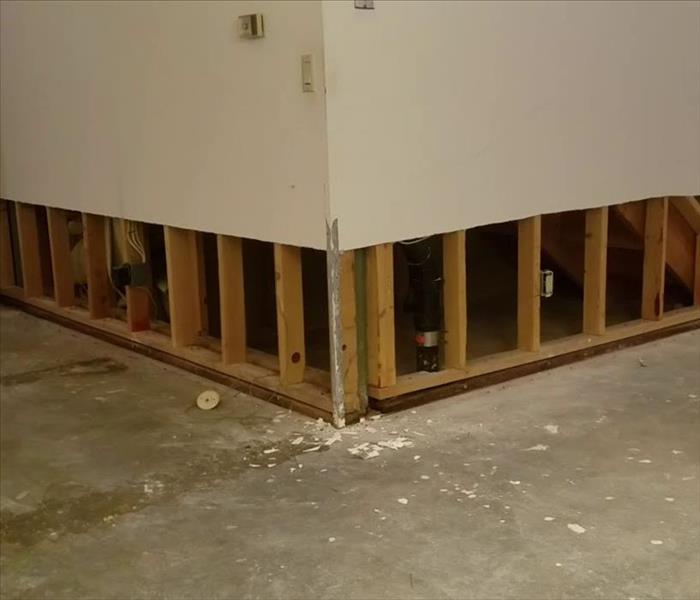 After a water damage event, many components may be discarded. Restoration is the process where these materials are replaced and repaired.
After a water damage event, many components may be discarded. Restoration is the process where these materials are replaced and repaired.
You would think that water-damage restoration and water-damage mitigation are the same things, but they are not. Water damage restoration is the process of repairing your workplace after it has been flooded, whereas water-damage mitigation is the process of preventing more damage. Water-damage restorations may restore your office's appearance from a shambles to its original state. Because water damage is a delicate process, it should be handled by trained specialists familiar with restoring a messed-up home to a livable, pre-damaged state.
While it's normal to be frightened when your house is flooded or inundated by another source of water, it's also important to realize that you must act quickly. The longer you wait, the greater the damage will become—and the amount of time it will take to clean up the water will grow. After reviewing the causes of water damage and their categories, it's also important to consider ways to prevent water damage in office environments.
Water-damage prevention should be considered as early as the foundation of a building or while designing the structure. Investing time is the most effective technique for minimizing costly water damage. On the other hand, regular inspections can aid in the prevention of leakage-related issues. Inspect various aspects of a corporate structure at different periods. One method for preventing office water damage is to set up a flood-monitoring system. Regardless of where your office building is located, having a flood warning system in place might be crucial in predicting floods. Internal plumbing failures, overflowing rivers, and melting snow are all possible flood sources.
Rescuing Your Wet Carpet and Drywall
11/2/2021 (Permalink)
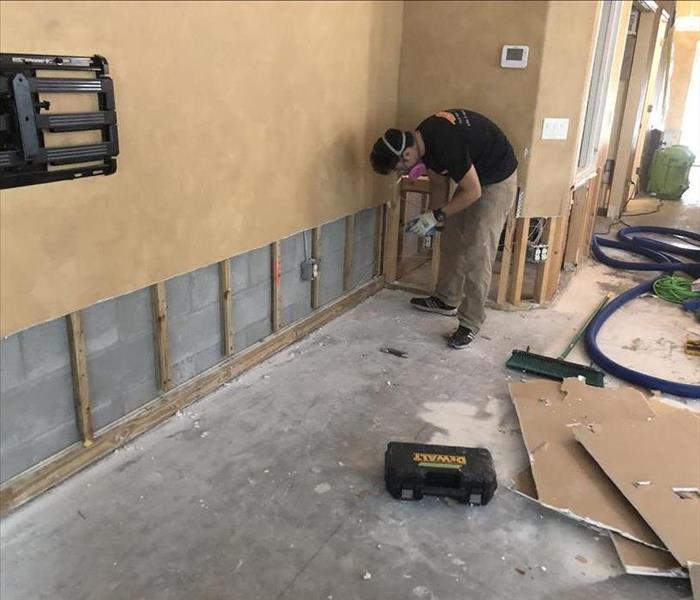 You do not have to replace the entire drywall if it isn’t all damaged. Flood cuts are made removing the drywall up to a certain height where the
You do not have to replace the entire drywall if it isn’t all damaged. Flood cuts are made removing the drywall up to a certain height where the
Whether it’s caused by a broken pipe, storm, or septic overflow, water damage of any kind can cause a great deal of stress. Fortunately, the severity of the disaster will determine the severity of damage done. Smaller floods made by leaking faucets may leave less damage, whereas larger ones made by burst pipes or storms can be more destructive.
Regardless of the flood’s cause or size, there is sure to be some amount of damage done to your home. You may be able to save some drywall and flooring by bringing in professional water cleanup and restoration services as soon as possible. Unfortunately, others may be beyond repair and/or create a hazardous environment if the affected areas weren’t adequately cleaned and restored right away.
To learn how to choose between restoration and replacement, let’s take a look at how and when to repair your carpet and drywall after suffering water damage.
What Happens When Carpet Gets Wet?
Spilling a glass of water on your carpet and letting it set is one thing. Letting water sit after a flood is another. If you fail to remove the water from the carpet promptly, then you’re putting yourself and your carpet at risk of further damage. This includes, but isn’t limited to, mold exposure and damage to the carpet padding.
Depending on how long the water is left for plays into the amount of damage. The longer the water sits, the more mold, bacteria, and structural damage can be done to your home. The sooner you’re able to intervene to stop the water damage, prevent it from spreading, and begin drying and addressing the damage, the better.
Should Wet Carpet Get Replaced?
In some instances, your carpet can be saved. If your carpet was minimally damaged by clean, clear water — like from a water spill or faucet leak — and can be thoroughly dried, then chances are it can be saved.
However, carpeting that has suffered more severe water damage will need to be replaced. Signs your carpet needs to be replaced after a flood includes:
- Damaged carpet padding and/or subflooring;
- Lingering stench;
- Signs of mold and mildew;
- Significant stains.
You can always speak to a restoration professional to get a second opinion on whether or not your carpet should be replaced.
What Happens When Drywall Gets Wet?
Unfortunately, some people are all too familiar with dealing with damaged drywall as a result of water damage. No matter if it’s a result of a flood, burst pipe, or storm, wet drywall can be a hassle to tend to if left for too long.
Even areas with high humidity levels like Florida and Louisiana are all too familiar with drywall damage due to an abundance of moisture.
Similar to a water-damaged carpet, water-damaged drywall must be treated right away. If left without being repaired, chances of mold, mildew and structural damage will increase. Signs of water damage in drywall include:
- Flaking/peeling paint;
- Mold;
- Musty smell;
- Soft spots;
- Warping;
- Water stains.
Be sure to contact your local water cleanup and restoration company if you see any of the above signs in your home.
Should Wet Drywall Get Replaced?
If your drywall only has a few stains, then you should be able to remove the damaged areas, paint over them, and keep the structural integrity. If it received more intense damage like warping or molding, then it will need to be replaced as soon as possible. The damage will only get worse if left unattended for too long.
You do not have to replace the entire drywall if it isn’t all damaged; rather, you only have to replace the affected areas. An example of this is flood cuts — cuts that are made removing the drywall up to a certain height where the flood water damage has occurred, to strategically expose the material and allow it to dry without destroying the entire area.
How To Dry Out Wet Carpet
For the carpet that you were able to salvage, it is crucial to ensure it is completely dry before reinstalling it. Listed below are a few tips and tricks on how to dry out wet carpet:
It is crucial to ensure your carpet is 100% dry before reinstallment. Failure to do so can result in mold or mildew.
How to Dry Out Wet Drywall
One of the first things to do when drying out your drywall is to remove any moisture from the surface using an absorbent towel. From there, you will want to assess whether or not it is salvageable or needs to be repaired.
If no repairs are necessary, then you may want to consider the following tips on how to dry out wet drywall on your own:
- Invest in a dehumidifier or dehumidifying services;
- Open up windows and doors for a natural, recurring breeze;
- Point fans at the wet spot;
- Remove baseboards, wallpaper, and wall molding to prevent moisture build-up.
Remember, your walls must be completely dry before resetting and painting.
Getting Professional Help
For those tough cases where the water damage is just too much, don’t be afraid to throw in the towel and seek out professional help. As soon as you recognize a burst pipe or other water damage, call in local experts in water damage restoration and mold remediation who have a trained eye that allows them to identify signs of water damage and mold, repair any damage, and prevent water damage from happening in the future.
What Are Flood Cuts and Why Are They Necessary?
8/20/2021 (Permalink)
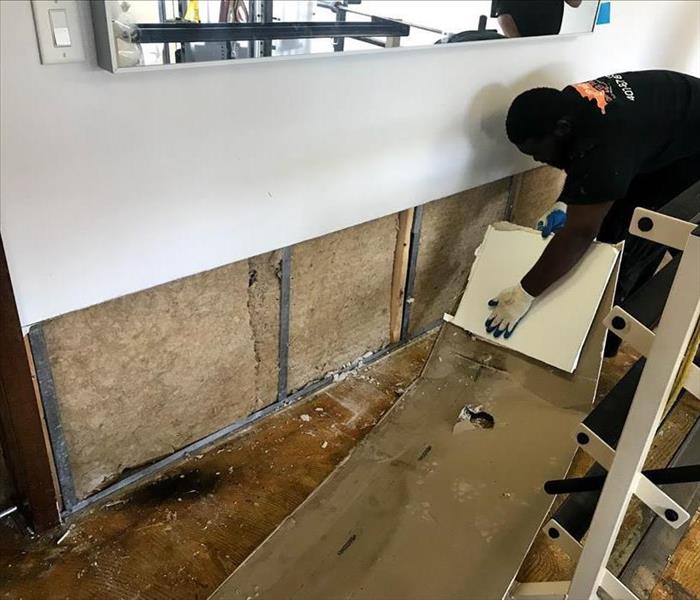 A flood cut is removing the drywall up to a certain height, especially in a flood-affected area.
A flood cut is removing the drywall up to a certain height, especially in a flood-affected area.
Floods are an environmental hazard. They destroy property and cause a lot of inconveniences. A flood may seem harmless since the water is colorless, but it contains ill-causing components such as bacteria and chemicals. Not to mention that it may cause significant financial losses in your home.
A flood cut will help tackle the issues related to flooding.
What are Flood Cuts?
A flood cut is removing the drywall up to a certain height, especially in a flood-affected area. Often, it is about 12-18 inches above the place the waters last marked.
Why Are Flood Cuts Necessary?
A flood cut prevents contaminated floodwater from finding its way into your pipes. After the excess water occupies your area, you may consume contaminated water, leading to illness for the whole family.
By cutting out a section of the drywall, flood cuts will ease access to the affected area. If you want to repair the areas damaged by the water, a flood cut will make it easier. You can treat the afflicted areas directly and more conveniently.
It also enhances the dry-out phase. Keep in mind that a moist wall may develop mold growth on it. You may get respiratory infections such as tonsillitis and pneumonia due to a damp wall. A wet room can also impact your immune system.
How Do I Make a Flood Cut?
Ensure that you have the following Apparatus
• Chalk Line
• Ruler
• Hammer
• Utility knife or jab saw
The following steps will then guide you:
• Create a straight line above the place where the water last touched. The line should be straight so, use a ruler.
• Use a utility knife to cut through the line. Be careful not to cut deep. (To avoid any injuries, wear protective gear)
• If you do not have a utility knife, then you can use a jab saw.
• In the cut section, poke a small hole using a hammer.
• Hold on to the puncture then, gently pull out the intended cut-out. Do not use too much torque to avoid damaging your drywall.
Remove all the insulation underneath the wall. However, if it is a plastic insulating material, you may leave it to dry out on its own.
Opt for dehumidifiers or highly efficient blowers to dry up the section. You can also open up the windows and doors for natural air circulation.
How Will I Restore It?
Know how much material you need in the first place by measuring the cut-out space. You will not end up wasting resources if you get an accurate measurement. Proceed with the detailed steps below:
• Put four drywall clips in the area surrounding the hole. (You should place them on all four corners of the cut area)
• On top of the clips put a drywall screw for support.
• Insert the drywall pieces onto the drywall clips.
• Carefully seal them with a drywall screw. Be careful not to over-tighten.
• To blend it in with the existing drywall, use a compound joint.
As soon as it dries up, you may paint it with mold-resistant paint.
Is It Always a Must to Flood Cut?
No, it isn't. If the water leak was from a clean source, there is no need to cut out your wall. You may use an injection system to wither the wall. A wall with no insulation also does not need a flood cut.
Make Sure You Consult First
Ensure to only practice home maintenance tips that you can handle to avoid incurring losses. Keep in mind that every home needs a specific type of care. So get a consultation from an expert first.
Dry Out After Water Damage
6/22/2021 (Permalink)
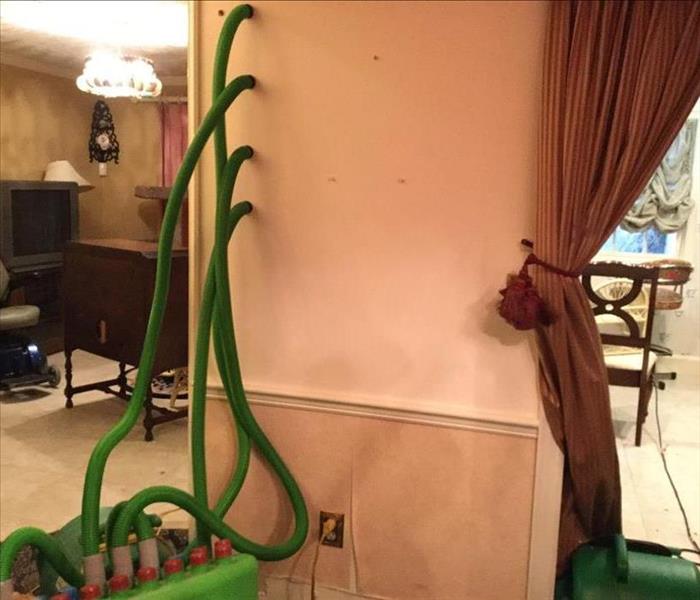 Aside from knowing how much equipment to place and where our technicians are trained in other drying methods to be as efficient as possible.
Aside from knowing how much equipment to place and where our technicians are trained in other drying methods to be as efficient as possible.
Water damage happens due to several factors like flooding, high humidity, or water leaks. This damage can cause problems in your home, and it can compromise your loved one's safety. Molds and dirt yield in moist and damp areas. You may need a company that repairs water damage suppose your place is prone to floods. You should call these experts to dry out your home as soon as floods occur.
These damp conditions might worsen if you do not use the right tools and tactics to dry your home. The damages might be expensive and cause health effects. That is why hiring SERVPRO of Winter Park is the best solution.
Why Hire Water Damage Companies?
Hiring a water restoration company is the best way to deal with floods in your house SERVPRO of Winter Park has the right skills to handle these issues. It is challenging to dry the home because you might leave out important parts like the basement. Also, it is hard to clean your house after water damage, especially if it is significant. However, SERVPRO of Winter Park will handle that for you.
Why Should You Dry with Our Equipment?
It would help if you did not try any DIY techniques when you flood your house because it can worsen the situation. However, drying out is the essential step when restoring your water. Experts from SERVPRO of Winter Park work hard to make sure your home is clean and dry. We use top-notch equipment, so do not worry about your home's safety.
These experts will examine your place and look out for important factors like moisture and humidity.
Types of Water Damage
Below are the main types of water damage:
1. Damaged pipes
Damaged or broken pipes can cause significant damage, and you should replace them as soon you notice them. You might need SERVPRO of Winter Park to achieve this. Most damaged pipes are included in the insurance policies, but damages that happen from neglect are not included. Some warranties cater to bills caused by faulty water heaters.
2. Structural damage
Water damage might cause a structural issue at your place, and this makes the area inhospitable. This water seepage in the basement or on the floor might make the home structure week and later collapse.
3. Cleanups at the sewage
Cleanup happens when you back up toilets or sinks. Black or greywater seepage is the main result of sewage spills. Cleaning up your sewage is a nasty part of the restoration procedure, and it can cause health effects. It would be great to conduct this activity with the help of SERVPRO of Winter Park.
Causes of Water Damage
Several factors cause water damage, like damaged pipes, gutters, faulty roofs, among others. In addition, homes that lack proper aeration are more likely to get mold, especially in neglected places.
It is hard to prevent water destruction because some natural factors also cause it, like storms. But you can avoid extra damage by knowing its causes.
1. Leaky roofing system
Faulty roofs will let the water reach your home, causing massive damage. You might also see water deteriorate if you have old and damaged roofs. You might think that your old roof is okay until a heavy downpour occurs. In most cases, the harm occurs, and homeowners might not notice it for a long time.
2. A faulty pipe
Damaged pipes can destroy your home by a slow leak. Plumbing problems occur, but their intensity depends on the water amount. Broken pipes cause damage, especially if the hoses in the washing machines burst.
Damaged pipes also cause issues that develop, like when water starts dripping from damaged parts.
3. Condensation
This is one of the most common causes of water contamination in many homes, but most people overlook it. This condensation happens when there is a leak or when the pipes do not drain well. With time, the condensation goes through walls and floors, causing mold.
Risks of Water Damage
There are many dangers of water damage to homeowners, both financial and emotional. Here are some risks:
1. It destroys property
One of the most common effects of water damage to your house is jeopardizing your property's safety. It is hard to rebuild most of these items destroyed by this damage. Water damage might destroy your crucial documents, clothing, and electronics, among others. This damage might also destroy essential structures in your house.
2. It may cause health effects
Water damage has a long-lasting effect on your health. Mold multiplies in moist areas, and they can cause health effects. They also attract pests and lower the air quality. Therefore, this means you should repair any water damage when you notice it.
3. Increases pest infestation
Most pests and bugs love moist areas. Unaddressed water collections also bring these critters to your place and cause further damage. Pests like cockroaches and centipedes bring moisture to your home, so you should avoid this by repairing any damage.
How to Dry Water from Damage
You can do the following things to dry out water:
- Knowing where the leak is and repairing it
- Repairing damaged walls
- Look out for mold
- Seek help from an expert
Water damage is familiar to most of us, and it happens due to reasons like faulty pipes and a leaky roof. It would be great to repair these faults to make sure they do not escalate. In addition, repairing these faults will keep your loved ones free from danger.
How Dehumidifiers Work and Their Importance in Restoration
5/26/2021 (Permalink)
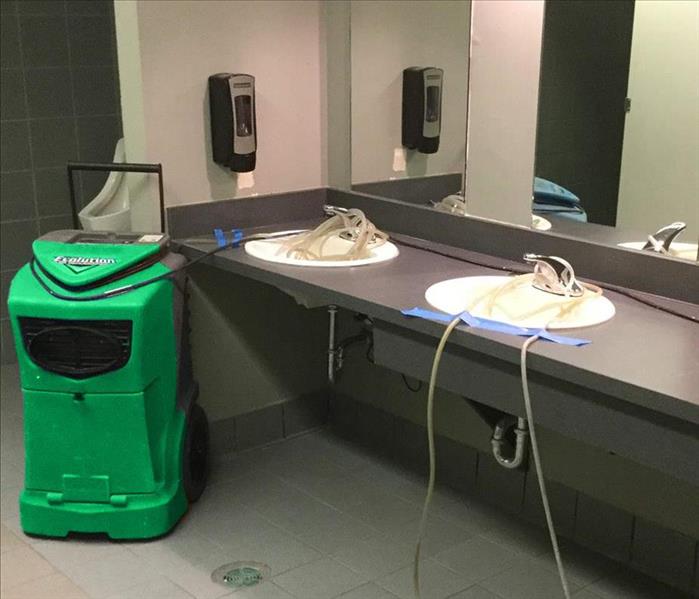 A dehumidifier removes moisture from the air and helps prevent the creation of an environment for mold growth to thrive in.
A dehumidifier removes moisture from the air and helps prevent the creation of an environment for mold growth to thrive in.
What Is a Dehumidifier and What Does It Do?
A dehumidifier is an electrical machine used to extract excess humidity or foul smells from the air. It is also great for mold prevention. Moisture levels in a building come from several things. Improper room ventilation while cooking and drying laundry makes house walls sweat. A room filled with strange odors, humidity, and particles is agonizing for people suffering from asthma or allergies.
Relief from Water Damage and Mold
Busted pipes, leaky roofs, or flooding challenges attracts potentially dangerous mold. If mold spores come in contact with damp or wet spaces, it grows and can potentially become toxic.
Homeowners and Business owners must stay abreast of any water leakages or flooding on the inside of the structure. Renovations due to excess water damage and mold can be costly. A dehumidifier is the best choice if your goal is to put a stop to mold. Mold lurks in damp environments.
A dehumidifier draws in the moist, humid air through an evaporator coil then through a condenser coil. This procedure transforms the previous moist, damp air into warm air. Once the air is warmed, it is then released back into the room while at the same time lowering the humidity within the building.
A significant issue that can occur within a business or housing complex is mold growth. However, when discovered right away, the risk is reduced to minimal. The key to preventing mold is finding where the issue occurred and extracting excess water as soon as possible. Once you locate the leak source, use water removal instruments to dry up the excess water.
The Functions, Pros, and Cons: Dehumidifiers and an Air Exchangers
A dehumidifier is similar to an air conditioner. Air coolers are for circulating cool air into a specific area of a structure. Keep in mind that ideal air circulation calls for fans and windows. It is also good to know that different types of wood or materials react differently to water.
An air conditioner cools the air down but can make for a humid, moist environment. In contrast, a dehumidifier dries the air, making it warmer, plus decreasing the humidity. Conventional AC units remove the moisture by cooling the air.
The size of the unit is essential to ensure the room cools quickly and efficiently. For instance, using a tiny air unit to cool a large area is a waste of energy and will empty your wallet. Switching to an air inverter conditioning system is an energy-efficient alternative to conventional air exchangers.
Window-mounted air exchange units do not always vent adequately. Because air exchangers are typically either on the outside fully or partially, the air travels through a wall vent, then through the evaporator. Finally, in the condenser coil, the warm air shoots outside the structure. Obstructions in a wall-mounted air unit reduce airflow, and the air conditioner unit gets overheated.
Cleaning up the Mess
Some water cleanups and restorations may require pumps and professional drying systems to dry excess water from walls, carpets, and ceilings. Also, be aware that materials do not react the same when they come in contact with water. Warning, if you do not know how to extract excess water from a structure, please call a professional. It is imperative to use the right tools and protective equipment.
A professional will extract and mitigate (remove damaged materials) from the site. A professional uses precision moisture meters and thermal devices to pinpoint where the problem lies. It is crucial to keep in mind that water extractions can run you into thousands of dollars. Professionals require various types of tools for professional water damage restoration.
Air coolers maintain constant humidity levels, therefore preventing mold from forming. Air movers also blast out stuffy smells from a room. Lastly, wall or window-mounted air conditioners are easy to operate. The downside of running an AC unit around the clock, however, is enormous energy consumption.
Water extraction is necessary for massive floods such as busted pipes or natural disasters. However, for a do-it-yourself cleanup, a dehumidifier is an excellent device to get started. Even better, a dehumidifier teamed up with a commercial air mover (fan or air conditioner) works for restoring a severely damaged wet area.
Humidifiers and Air Coolers Working Together
Merging these devices is a quicker and more effective means of restoration. This method ensures that mold will not creep in at a later time. Joining an air mover with a dehumidifier reduces future damages to the structure. When it comes to decreasing moisture levels, air coolers alone cannot measure up to a dehumidifier.
An energy-efficient inverter air system can save about 70% on the next power bill. Note, however, that dehumidifiers use only a tenth of your electric power. Dehumidifiers come with built-in sensors that regulate the fan speed within the defrost system. Like other types of technology, machine technology is ever-changing.
Air conditioners alone eliminate about 18 gallons of water. Excess water causes potentially dangerous mold. Preventing mold is a primary reason people choose this duel system. Whether you choose a conventional, large, or compact dehumidifier depends on the size of the task.
An air conditioner teamed up with a dehumidifier is effective and removes moisture quicker. The main factors in getting efficient air are good circulation, dehumidification, and air purification. For specific spaces, portable AC modifiers have condenser evaporators that pull heat out of an area. These mobile units go where they are needed.
Condensation on Your Walls and What it Means
5/17/2021 (Permalink)
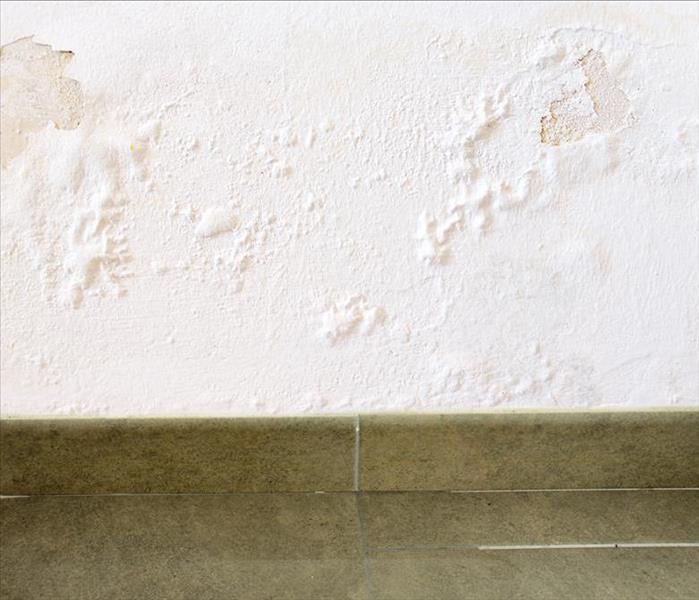 Condensation and moisture on your wall can lead to paint damage, sheetrock damage, and in many cases, mold growth.
Condensation and moisture on your wall can lead to paint damage, sheetrock damage, and in many cases, mold growth.
If there is condensation on your walls, you should do something about it. It may look harmless, but it is dangerous in the long run. Wet walls are a suitable habitat for mold and mildew, which can cause health effects. In addition to that, your walls may get too weak and collapse with time.
Signs of Wet Walls
There are various things you will spot if your walls are damp. For instance, you may encounter some damp, musty odor every time you walk into a room, and yet there is nothing damp in the room. There may also be dark marks on a wall, and the plaster looks discolored. Additionally, you may notice that your wallpaper or paint is peeling off.
Causes
The leading cause of wet walls is condensation. Other causes are leaks and drainage, and damp issues. Below is a breakdown of the causes and what to do about each of them.
Condensation
Condensation appears on your wall when excessive hot air in the house settles on the cold walls and cools, thus turning into water. Excessive air often results from cooking or the shower.
You can employ the following remedies for condensation:
Have An Exhaust System
Install an exhaust system in your kitchen and bathroom to suck out the steam instead of having it waft around the house. You can also ensure you close the door and keep the windows open while showering or cooking. Ensure you cover the pots and pans as the food cooks to prevent too much steam from escaping in the kitchen.
Have A Proper Ventilation System
You need to ensure that there is as much breathing space as possible in your house. This can be as simple as committing to open the windows as often as possible so that hot air goes outside instead of settling on the walls.
Invest In a Dehumidifier
This is a machine that sucks excess moisture out of an enclosed area. It will be a great addition to your home to aid in fighting condensation.
Keep Your House Warm
Try as much as possible to ensure your house is warm. This way, the walls won’t turn cold, and there will be no place for air to condense. Turn on your heating system at regular intervals and keep the fireplace burning if possible.
Hang Your Clothes Outside
When you do your laundry and put it to dry in the house, they release the moisture into the house, and it will inevitably land on the walls. Air it outside instead. If that is not possible, get a tumble dryer or place a humidifier close to the clothes to absorb the moisture. Note that if you choose to get a tumble dryer, you will need to install an external ventilator or get one that is self-condensing.
Leaks
Apart from condensation, leaks can also make your walls wet. These leaks can result from faulty pipes, either due to wear and tear or poor installation. The leaks can also be from the roof because of broken tiles. The water from these places slowly seeps into the wall. Gradually, you will start noticing the signs of dampness on the wall.
The best way to deal with this is to schedule an inspection to identify the source of the leak. Once you figure that out, contact a professional to fix the issue as soon as possible. It is advisable always to inspect your roof for leaks at least twice a year to avoid the risk of water damage. When you ignore leaks, they may cause damage that will cost you more than you would have spent on repair.
Rising and Penetrating Damp
Rising damp is where water seeps into a wall from the bottom. Penetrating damp, on the other hand, is where it seeps into a wall from any source. This can even be a result of a leak. For rising damp, the most effective solution is to fix your drainage system so that water does not come into contact with your walls. You also need to repair the damages brought about by the damp and work on your ventilation.
More Helpful Tips
To prevent condensation, you can also ensure your gutter and downspout system is in perfect condition. Apart from that, if you have lots of houseplants, consider taking a few of them outside. Plants also release moist air, and too much of it may exacerbate your condensation issue.
If the condensation on your walls has already caused molds to grow, get rid of the molds by using mold spray, wiping them down with a wet cloth, or one steeped in diluted bleach. Before you repaint or install new wallpaper, ensure you have completely gotten rid of the wetness on your wall.
Always engage a qualified professional to help you determine the extent of your problem and suggest the best course of action to take.
Conclusion
Because wet walls can result from many different things, be sure to establish the cause before choosing a remedy. Otherwise, you run the risk of fixing the wrong thing, and the problem will keep recurring. Note that it is always best to prevent something than to fix it. So even if you aren’t dealing with condensation yet, you can always put in measures to ensure it does not come up. For more information on condensation and how to deal with it contact SERVPRO of Winter Park.
Cupping, Peaking, and Buckling Wood Floors
5/6/2021 (Permalink)
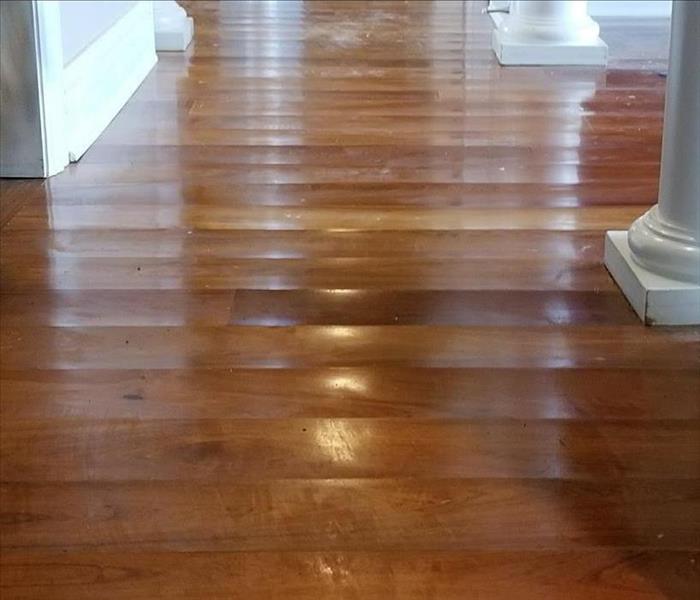 Cupping is the result of an increased moisture content that saturates the bottom of the boards.
Cupping is the result of an increased moisture content that saturates the bottom of the boards.
Wood Damage from Water, Age, or Installation
Having wooden floors or engineered hardwood flooring can be a challenge even when things are going well. It is strongly advised people who want this type of flooring have a professional install them. Wooden floors and engineered hardwood flooring can develop issues that may alter the appearance and shape of the wood. There are more things to be concerned with in addition to water damage when caring for wood floors and engineered hardwood flooring. The most common problems are buckling, peaking, and cupping.
Moisture Damage
Even if someone's floors experience moisture damage, there won't be any need to replace the entire floor. Buckling, crowing, and cupping is used to describe the warping as well as damage experienced by engineered hardwood flooring and wood floors. These conditions are caused by changes in humidity, moisture, groundwater, and more.
Humidity And Moisture
People want wood floors and engineered hardwood flooring because of the improved appearance they provide in any space where they are placed. They are also known for being sensitive and delicate. Warping and disfigurement can occur from humidity and moisture. It may be possible to control the humidity of a home. Moisture can still become an issue even if a home has no problems with flooding or leaking pipes.
Relative Humidity
The air in any space inside an enclosed area will have humidity. There will always be water vapor in the air unless it measures zero. Over time, the wood in a home such as the doors, walls, and floors will adjust to the humidity levels. It will reach equilibrium. This is why it is common to hear a house settle. The floorboards will creak when experiencing weather that disturbs the equilibrium. When a home experiences extreme changes in the moisture, it will cause the floorboards to warp.
Buckling
This can happen when floorboards aren't given the opportunity to adjust to the climate in a home. This will occur when a person notices floorboards pulling away from the sub-floor. The floorboards bow inward. They may also come right off of the floor. This could also be the result of poor installation. The newly installed wood has to have room to contract and expand and adjust to changing humidity levels and temperatures. If the floorboards don't have enough space, they will buckle.
Peaking
This is an expansion issue. The main reason this happens is problems with the installation. Wooden floors are regularly contracting and expanding based on the humidity level in a home. The weather and temperature also play a role. This should be a consideration during the installation process. It is important for there to be the proper space between each floorboard as well as space between the flooring and the walls. If this isn't done, the wood won't be able to properly expand. There won't be any room for the wood swelling. This will result in peaking.
Cupping
This occurs when excessive moisture impacts the underside of floorboards. The surface of the boards will seem to be cupping and have a concave shape. The side of the boards will be higher than the middle of the boards. They will bow inward. Engineered hardwood flooring and wood floors can experience cupping. This is different from other types of damage because of the location of the moisture damage. The bottom of the boards becomes saturated with moisture. This situation can occur over a few days. The reason for it is probably underlying water damage. This could be part of a serious problem like leakage and groundwater. It is something to be resolved by a professional plumber. It is also possible for boards to cup because of too much water vapor in the air. The boards will then warp much slower. This is a challenge to detect since there will be no immediate changes.
Repairing Common Issues
When it comes to cupping, it is possible to repair it by sanding the floor. This will make the boards even. Before sanding the floor, it needs to have enough time for the moisture content to return to normal. Should this not be done, it can cause peaking. When the boards are bent upward, sanding shouldn't be done. It is possible to spot treat places that buckle or peak. The boards that have been affected can be removed and given time to dry and then replaced.
People don't have any real control over unexpected moisture issues. Damage can result from unexpected flooding as well as leaking pipes. It's also not possible to do anything about the moisture or humidity in the air. The floorboards of wooden floors or engineered hardwood flooring can be protected by covering them with a sealant product. It is also recommended to have a dehumidifier running in rooms where hardwood floors or engineered hardwood flooring is located. This will take out the dampness or high humidity that is present.
The SERVPRO Water Damage Restoration Process
4/26/2021 (Permalink)
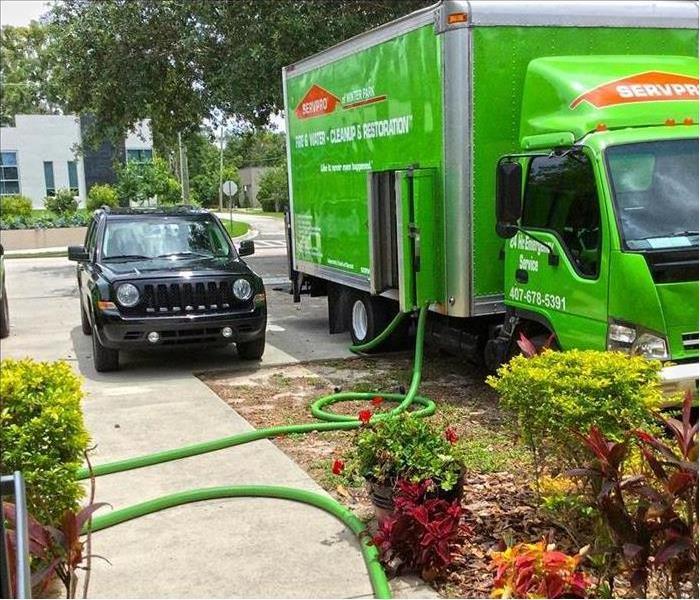 Excess water is extracted from a property using tools like an extraction wand that sucks up water and feeds it through to one of our truck mounts.
Excess water is extracted from a property using tools like an extraction wand that sucks up water and feeds it through to one of our truck mounts.
SERVPRO of Winter Park has the expertise and equipment to quickly restore your property to pre-water damage conditions. We use a scientific approach to water removal and water cleanup that emphasizes monitoring and documenting the drying process from beginning to end.
Have Water Damage?
Call Today (407) 678-5391
Every water damage event is a little different and requires a unique solution, but the general process stays the same. You can click on any of the steps below to learn more about that process.
When you call, our specialist will guide you through several questions that will help our team respond to your water emergency more quickly and efficiently. This initial contact is an important part of a fast, effective restoration.
They carefully inspect your property’s water damage, determining the type of water damage and the areas affected. This is a crucial step to creating an effective plan of action that will result in a successful restoration.
Typically, hundreds to thousands of gallons of water are removed using our powerful pumps and vacuums during the water removal process. The SERVPRO of Winter Park starts this process as soon as possible to minimize further damage and to help prevent mold growth.
After the bulk of the water has been removed, SERVPRO of Winter Park uses specialized equipment to target the water that’s harder to access. They use less intrusive, scientific drying methods to draw the remaining water and moisture from your property with air movers and dehumidifiers.
Water damage also affects your belongings, like furniture, clothing, and personal items. SERVPRO of Winter Park Professionals can clean restorable items using a number of specialized cleaning techniques. They also sanitize with antimicrobial treatments and remove odors using industrial air scrubbers and fogging equipment.
The last step is restoring your home or business back to its pre-water damage condition. The restoration step can be relatively minor, such as replacing a few drywall panels or could include major reconstruction, such as rebuilding entire rooms of a home or business.
Orlando Water damage is a big disaster for your home
3/4/2021 (Permalink)
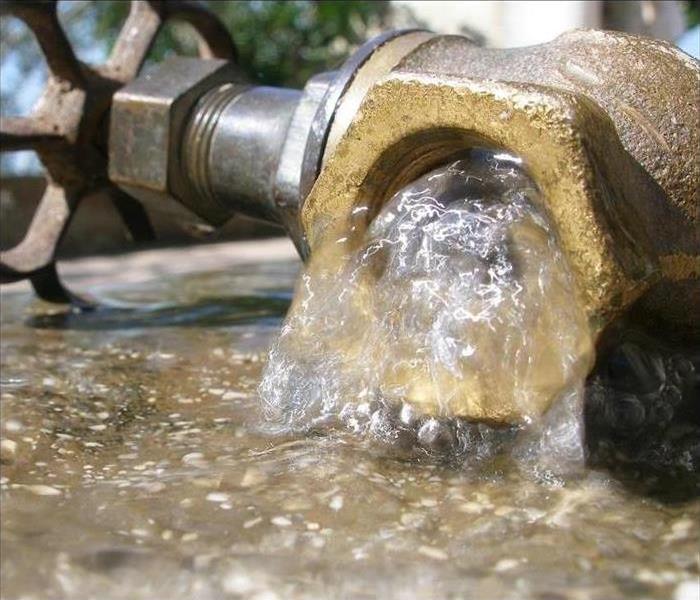 If a pipe bursts in your Orlando home and floods the house, insurance should cover it.
If a pipe bursts in your Orlando home and floods the house, insurance should cover it.
It's devastating when you find out that your insurance doesn't cover your Winter Park damage.
Orlando Water damage from a flood or a burst pipe in your home can be devastating, and the damage can linger for months or years in different forms. What can make the disaster even more devastating is finding out that your insurance doesn't cover it.
A good rule of thumb, when thinking about sudden water damage to your home is that if it comes from inside or above, you generally are covered. If it comes from the ground or below ground, you generally aren't.
For example, homeowner's insurance policies, as a general rule, do not cover damage from flooding. This includes a flash flood, where tremendous rain causes large amounts of water to flood into your home. It also includes a smaller event where water might seep up through your basement floor or cracks in your foundation to flood your home. Another type of event your homeowner's policy generally won't cover a backup of the sewer system, because that water comes from below ground. To cover damage from flooding, you need a separate flood insurance policy.
When the water comes from inside your home or above, your homeowner's policy is likely to cover it. For example, if a pipe bursts in your home and floods the house, insurance should cover it. If your washing machine or a toilet overflows and floods a room, insurance should cover it. Homeowners insurance also will cover rain damage from a storm if rain water got into your home because of damage caused by the storm. For example, if a tornado tore a hole in your roof, allowing rain to come pouring in, any water damage should be covered. On the other hand, if rain leaked through your roof because it was old and needed to be replaced, insurance may not cover it.
The best thing you can do is to examine your insurance policy and talk to your agent to make sure you understand what types of damage from water are and aren't covered. If you need to, there are riders you can add to cover other incidents that may not be covered under your original policy.
Keep in mind, too, that while your policy will cover some damage caused by sudden water infiltration, it will hardly ever cover damage caused over time, such as a leaky toilet that destroys a floor.
SERVPRO of Winter Park's professionals provide fire and water damage restoration services. We are available 24 hours/7 days a week and are ready to restore damage to your home or commercial structure caused by:
How to Stop Damage from a Window Leak in Orlando
6/12/2020 (Permalink)
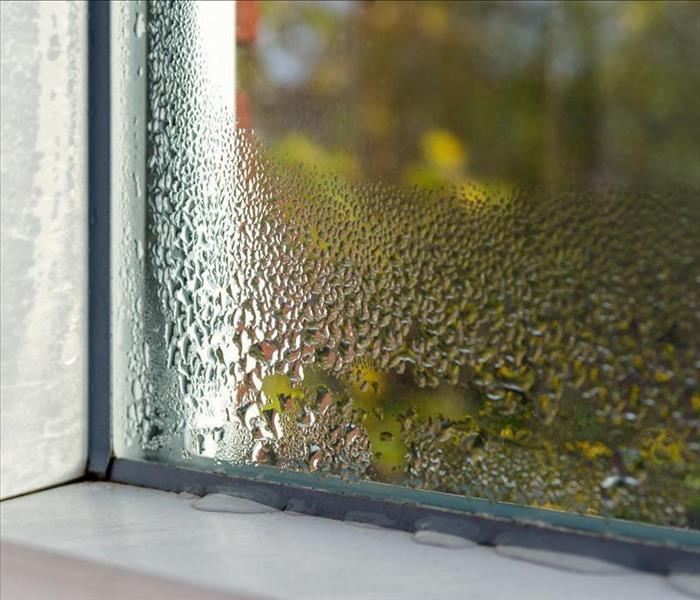 SERVPRO Has the Devices and Equipment to Keep Your House Dry
SERVPRO Has the Devices and Equipment to Keep Your House Dry
Water Damage Can Escalate Fast - Orlando Can Count SERVPRO
If you have identified a leak in one of your windows, it can lead to water damage in Orlando. Take steps to fix it quickly. If left to deteriorate, the problem will turn into something much more difficult to repair. It is very easy for invading water to cause additional damage and wood rot, so waste no time and call in an expert water damage team, if necessary.
Identify the Source
The first step is always to try and uncover the spot where the water is making its way inside. While this might sound simple, it can be very tricky. Just because you find water pooling in a particular spot on the sill or around the drywall, this does not mean that this area is the point of intrusion. Water will run with gravity, often quite far from its source. Take a close look at the whole window, focusing mainly on the frame, sash, and the edges of the glass. Carefully examine the caulking around the perimeter, because degradation of this material is a common cause of leaks.
A lot of windows only show signs of leakage if the rain outside is bad or there is a storm, so you may have trouble finding the source in dry conditions. You can, however, ask a helper to step outside and spray the window with water (from a bucket, hose, etc.), so that you have a better chance of discovering the water damaged problem area. SERVPRO can check with a moisture meter for hidden wet areas within the window area or adjoining walls and ceiling. Dehumidifiers and air movers can be placed to pull out moisture and increase evaporation.
Fix the Leak for Good
The only way to tell if you can repair the leak alone is to identify its source and assess how serious it is. If the water is entering in the flashing, above the window, it will need to be removed and upgraded. Or, you may need to replace the caulking around the window. If you are not confident about the outcome, call in a professional to do the repairs.
Water damage can appear in many forms. If water wicks into porous material like drywall or ceiling tiles, it usually has to be discarded. We recommend hiring a leak detector or plumber to find and stop the leak from the source. For any amount of standing water and/or moisture, it may be wise to call in SERVPRO for an assessment of the problem and suggestions for remediation. Don't allow a small quantity of water to cascade into a major, expensive water damaging event. We can restore water damage "Like it never even happened."
Highly-Trained Water Restoration Specialists
We are water damage specialists. SERVPRO of Winter Park gets your property in College Park, Orlando, and Baldwin dry and back to pre-water damage condition. We are ready 24/7 to help. (407) 678-5391
Who to Call After Your Orlando Home Has Sustained Water Damage
5/27/2020 (Permalink)
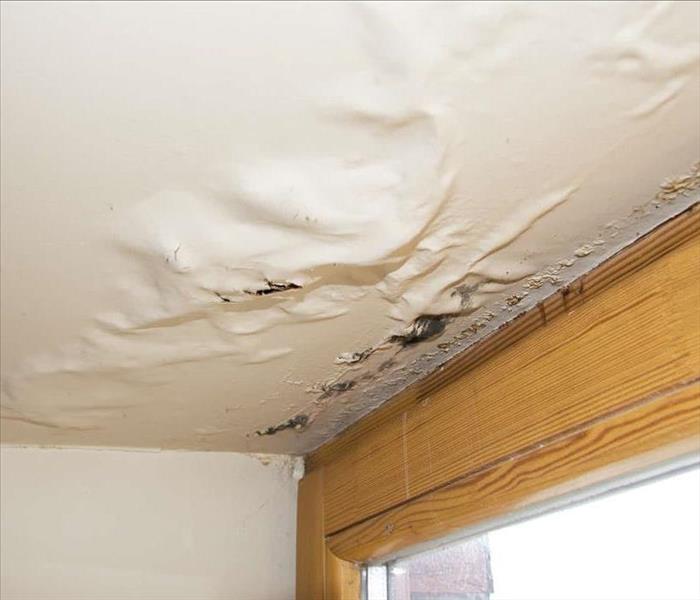 Having a professional at your property quickly following a water damage event can prevent further damage such as mold growth.
Having a professional at your property quickly following a water damage event can prevent further damage such as mold growth.
The Importance of Having Your Orlando Home Quickly Cleaned, Repaired and Restored After a Water Damage Event
As many homeowners know in the Orlando area, residential property subjected to water damage is susceptible to a large number of problems. In addition to possibly destroying your electrical system and the physical structure of your property, water damage can pose a plethora of health risks. And then the water flows along and leaves your personal possessions in ruins, more water damage! Despite these potential outcomes, help is a phone call away. A water repair and restoration company like SERVPRO can mitigate many of these events from ever getting out of hand by offering customized cleaning and restoration services. The key is to contact your insurance company and SERVPRO. Learn more about some of the steps that will be taken by this water removal company to restore your home to its previous condition.
Repairing Structural Damage
Another service that a water restoration company provides is the repair of structural damage your Orlando home may have sustained during the flood or fire. Unfortunately, water can cause substantial damage to the structure of your home. This repair and restore process can only start after the cleanup has been completed. The repair can then commence on damaged ceilings, wet drywall, and substructure work to any electrical and plumbing issues. Water can also adversely affect the sturdiness of the foundation and weaken the structure's framing. Water can make your home unsafe to enter.
Conclusion
If your home has been adversely affected by a flood or has incurred water damage due to the effects of a fire, it's important to know that a professional water removal company can assist you. These experts can help prevent secondary water damage and ensure that your home is safe and sanitary. Your search for immediate help should stop with SERVPRO. Our company's professionals are precise and passionate about offering the services necessary to get your home back to its original condition.
Locally Owned and Operated
SERVPRO of Winter Park is locally owned and operated so we are part of this community too. When you have a flooding or water emergency, we’re already nearby and ready to help. We take pride in being a part of the Orlando community and want to do our part in making our community the best it can be.
We are water removal experts and are ready to service your Orlando home. We're Faster to Any Disaster. (407) 678-5391
Water Damage Services Available Through COVID-19 Pandemic
4/22/2020 (Permalink)
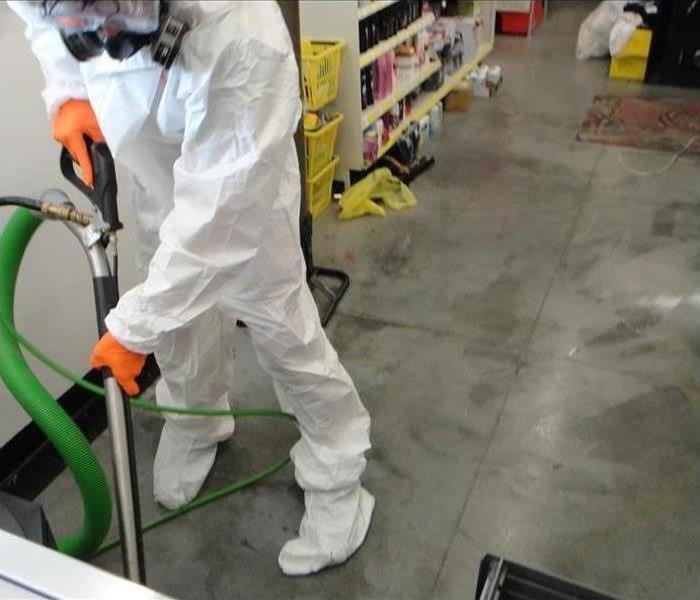 Our employees will practice social distance and wear safety equipment to protect themselves and our clients during COVID-19
Our employees will practice social distance and wear safety equipment to protect themselves and our clients during COVID-19
Our Valued Customers
As the coronavirus (COVID-19) continues to disrupt daily life, SERVPRO of Winter Park wants to assure homeowners and business customers that we are taking steps to help our employees and customers stay safe and healthy.
Aside from offering services to help sanitize and prevent the further spread of the virus, we are remaining available to the public 24/7 in the event of water damage emergencies. We understand that water disasters can happen at any time, without warning, and with or without a global pandemic.
Changes in the Process?
The majority of our Water Damage Restoration process will remain the same. The work that needs to be done to ensure proper water removal, structural drying, and mold growth prevention does not change. However, we will be taking extra precautionary measures to ensure the safety of both our employees and you, the customer.
We ask that social distancing be applied during water damage jobs and are instructing our water technicians to keep a distance of 6 feet from anyone within the home or business.
Our technicians are also provided with extra safety equipment to safeguard them from the invisible Coronavirus which can spread so easily. Although the water job may be simple and does not require it itself, our technicians will operate with safety as a first priority and will be equipped with masks and gloves for each and every job.
Our goal is to continue providing necessary emergency services to our community without also being a part of the issue. We will continue to operate with the best interest and health of all parties in mind. We ask that our clients notify us if anyone in their home or business has shown any symptoms of this virus prior to beginning work. Most importantly, we want our clients and the Central Florida community to know we are here for them and will do our part to get through this pandemic together!
Water Damage Services in Downtown Orlando
2/25/2020 (Permalink)
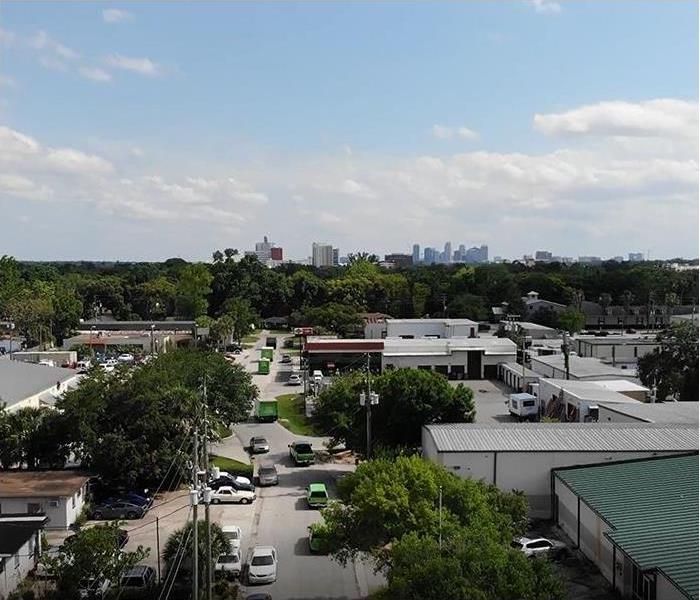 An aerial view above our warehouse shows just how close we are located to downtown Orlando
An aerial view above our warehouse shows just how close we are located to downtown Orlando
Water disasters come in many forms such as pipe bursts, water heater malfunctions, sink or toilet overflows, damaged ice maker lines, overflowing drip pans in air conditioning units and weather-induced flooding, just to name a few. With the near-endless opportunities for damage, it is important to know how to effectively deal with a disaster if it is your turn to experience one. A quick search on the internet will show that there are plenty of restoration companies servicing the downtown Orlando area. Among those companies, SERVPRO of Winter Park is the safest choice.
Why Should You Choose Our SERVPRO?
Distance from Downtown Orlando
Whether you own a nightclub, manage an office space, run a restaurant, live in a skyrise apartment, or own property in downtown Orlando, one thing is for certain. If you have water damage you need help fast. Many other restoration companies serve ads and also appear in online searches for water services in the downtown area, however, that does not necessarily mean that they have the fastest response time for the area, regardless of what they claim. SERVPRO of Winter Park has the fastest response time because we are physically located just north of downtown. The main image on the upper right side of this blog post captures an aerial view above our warehouse showing just how close we are.
Commercial-Scale Capability
SERVPRO franchises come in all sizes and our Winter Park location is one franchise that has the equipment and manpower to handle large commercial-scale water jobs. We have a large fleet of trucks that are equipped with mounts to hold an excessive amount of water. When we mobilize and arrive at a commercial water disaster, we can remove water from the property at an accelerated rate. SERVPRO of Winter Park also has two large warehouses nearby, enabling us to both keep a large quantity of equipment ready and store furniture and belongings offsite for clients.
Trained Water Damage Technicians
In today’s world, which is very pro DIY, handling a water situation incorrectly can lead to even more damage. When you choose to use our company to help your disaster, you can rest assured knowing that your property is under the care of experienced professionals that have been trained, tested and are equipped with the knowledge to handle various situations. Our experts on the ground will be able to walk you through the process every step of the way.
Discreet Services Available
Our franchise has a ton of experience in working with clients that require a more discreet approach such as theme parks or businesses that do not want to interrupt the flow of business by having big green SERVPRO trucks near their entrance or storefront. We completely understand this and consider every client’s needs before beginning work. We also respect company brands and make sure that logos or locations are not posted on social media channels.
Direct to Insurance Billing
Dealing with insurance can be a hassle with any claim and property damage from water is no different. Fortunately, SERVPRO is a preferred vendor for many of the large insurance companies and we are extremely capable and used to dealing with adjusters directly. This includes working closely with your adjuster to write estimates, determine line items covered, and finalize a bill. Our hands-on approach with your insurance takes extra pressure off of our clients and allows them to focus on their actual property. We can even bill your insurance directly in most cases.
What is the Water Damage Process Like?
The severity of a water damage situation can differ greatly and add new components to the process needed to effectively remedy the issue. All variables have to be considered before we begin. For example, a heavily saturated carpet may be salvaged but the padding underneath will have to be removed. Likewise, a water disaster resulting from a sewage backup will require additional cleaning and sanitization. However, regardless of the situation at hand, the base of the overall process stays the same for the most part. Here is what you can expect when giving us a call:
- Our office staff will answer your call and record all the information necessary to mobilize our technicians with the right amount of equipment for your specific situation. If an insurance claim was made, they will also take your claim number and insurance company name to work with your adjuster.
- Upon arrival, our technician will assess the damage to determine the amount of equipment needed as well as record the necessary information needed to begin building a damage estimate.
- If standing water is present, we will remove baseboards and immediately begin extracting the water from the property removing as much moisture as possible.
- Drying equipment such as high-powered fans and dehumidifiers will be strategically placed to dry affected areas as quickly as possible.
- Non-salvageable components of affected areas such as carpet padding and drywall, which acts like a sponge and can draw water up past the flood line, will be removed and discarded.
- Our general contractor will replace and restore items that were discarded during the water loss.
- SERVPRO of Winter Park will provide you with a bill or invoice your insurance company directly if a claim was established.
Have You Experienced Water Damage in Downtown Orlando?
There are many companies to choose from to help you with water damage in downtown Orlando. However, if you are looking for the fastest service without having to sacrifice quality, SERVPRO of Winter Park is the logical choice in your area. Give us a call today at (407) 678-5391 and remove that water from your property!
Is Insulation Salvageable Following Water Damage?
12/11/2019 (Permalink)
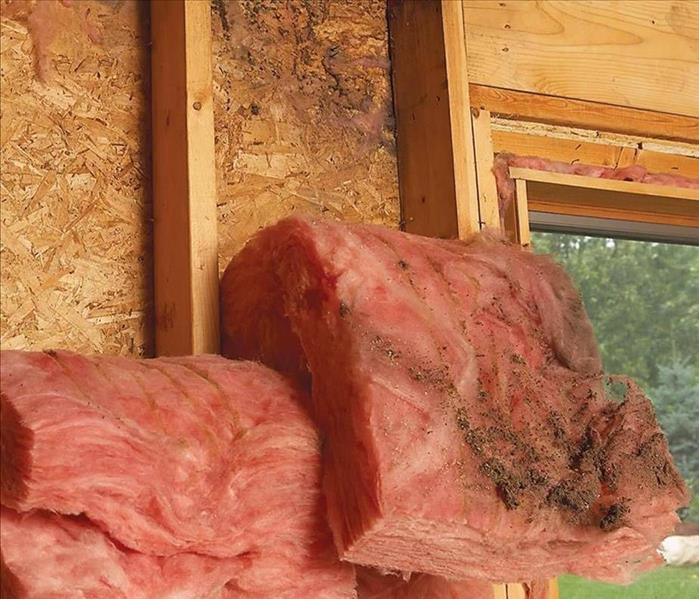 Insulation that is affected by water damage can lead to structural damage from both wood rot and mold growth
Insulation that is affected by water damage can lead to structural damage from both wood rot and mold growth
Homeowners who have experienced water damage from a leaky roof or a burst pipe often ask us if they can salvage the insulation in their attics or walls that have been exposed to large amounts of water. Theoretically, the answer is yes in many cases. Some popular types of insulation include fiberglass blanket, blown-in cellulose, and foam board. Depending on your type of insulation and level of water exposure, it’s possible to dry out wet insulation and put it back in its place. However, doing this takes a lot of time and effort. Here are four good reasons to replace your insulation and not salvage it.
1. Reduction in Insulating Performance
Your home’s original insulation that was installed by your builder has a rating that impacts how hard your HVAC system works to keep your home comfortable. If fiberglass or cellulose insulation products become wet, they lose their insulating properties. While it’s possible to dry fiberglass insulation, cellulose insulation is made of paper fibers and is harder to dry when water damage is widespread.
2. Invitation for Mold Growth
The presence of mold has been linked to various negative health effects. Mold needs moisture, food, and warmth to survive and thrive in your home. Wet insulation in your attic offers the ideal breeding ground for mold spores. Mold spores reproduce rather quickly. By the time that you realize your insulation is wet, these spores have likely already infested your old fiberglass or cellulose insulation. Homeowners who have foam board insulation aren’t entirely free from problems in this area either. While foam boards aren’t attractive to mold, the spores love attaching to the wood frames that surround them. The introduction of mold growth will have a serious impact on the amount you can expect to pay water damage and mold remediation companies to take care of your damage.
3. Encourages Wood Rot
Wet insulation that’s trapped in a wall cavity can weaken your home’s frame. If wet insulation isn’t properly removed or thoroughly dried, it can moisten your home’s wood framing and cause wood rot. This is also true of foam board insulation that doesn’t absorb water but that traps moisture close to surrounding wood frames.
4. Attracts Pests
Termites, carpenter ants and other pests love moistened wood, cellulose, and pulp. A colony of termites usually has over 60,000 members, and they can eat through a foot of a 2x4 in about a year according to industry experts. Termites cost American households millions of dollars in home repair projects each year. You can stop them in their tracks by fixing any leaks and replacing wet fiberglass and cellulose insulation with new insulating materials.
Conclusion
If you have experienced water damage in your property, SERVPRO of Winter Park is your first step towards taking care of your water disaster. We are expertly trained to remove all moisture and non-salvageable materials, such as installation, and get your property completely dried before mold begins to grow. We are also expert remediators should you already have a mold growth situation. Prevent further damage to your property and give the experts a call at (407) 678-5391.
How to Avoid Claim Denials for Water Damage
7/5/2019 (Permalink)
 Asking your insurance adjuster if you're more likely to be approved or denied when they're on-site is an opportunity to get answers to concerns.
Asking your insurance adjuster if you're more likely to be approved or denied when they're on-site is an opportunity to get answers to concerns.
Home insurance claims stemming from water damage are among the most frequent of insurance claims around. We will cover water damage types, what damage is covered and what claims are typically made by homeowners. We will also cover why home insurance companies deny certain claims and how to avoid these denials.
Types of Water Damage
There are many kinds of water damage. Different homeowner’s insurance policies will cover different types of damages and situations. Some of the more common sorts of water damage that will show up on a policy as either covered or excluded from coverage include:
• Water damage caused by heavy storms
• Flood damage
• Water backup or sewer backup
• Accidental or sudden discharge
• Overflow
Home Insurance Claims for Water Damage
Homeowners usually want to know what sorts of water damage will be covered by their policies. Common types of water damage inquiries are for leaks, such as from leaky roofs, toilets or pipes around the house that distribute water. Coverage for water damages will be determined by the damage’s origin, the policy that the homeowner signed up for and if the claimed damage is both sudden and accidental or if the damage was gradual.
Gradual Damage
Gradual damage is water damage deemed to occur slowly over a long period of time. Some forms of gradual damage will be hard to spot until it is too late, such as when the damage is occurring within the interior walls of a home. Though these sorts of issues can lead to structural damage down the road, most of these damage claims would be denied since they didn’t occur both accidentally and suddenly.
Homeowners frequently make claims ultimately caused by gradual damage such as the following:
• Leaky pipes, plumbing, and faucets damaging walls, floors, and ceilings.
• Watering seeping in from foundation weaknesses or from holes around the home’s exterior.
• Worn down tiles, flashing or other roofing materials that are allowing water to enter the home.
• Damage due to corroded, moldy or rotting materials.
• Electrical wiring that has become worn and less effective.
• Sub-standard home repairs or non-repairs.
Though not always, insurance companies may cover the “resulting damage” of issues or parts that originally wouldn’t have been covered by the present policy.
If a homeowner wants to know the finer details of what is covered and not covered in their policies, then it’s best to consult the insurance company or their insurance broker or advisor. They can go over the exclusions and details of a homeowner’s insurance policy for complete coverage details.
Reasons that Claims can be Denied
Homeowner’s insurance claims can be denied for a variety of reasons. Gradual damage, coverage lapses or miscommunications are just a few reasons for claim denials. No matter the reason, the homeowner should request a complete explanation of why the claim is not being granted. This includes an elaboration of which part of the wording within the policy doesn’t apply to what the homeowner is seeking compensation for.
Keep in mind that many people represent the home insurance organization during the claims process, so it’s a good idea to determine from whom the denial is coming from. Was it the contractor, an insurance agent or a claims adjuster? Each person has a different role within the organization, opening different paths for reviewing or negotiating through the process.
One reason for the claim being denied was that it was for an issue that the homeowner had to specifically request or endorse beforehand. It’s one of the homeowner’s rights to know what conditions were covered on their policies for present and future reference, including the optional endorsements and features.
How to Avoid Claim Denials
• Keep records of home repairs, including the names of the professionals hired for the home’s maintenance.
• Maintain an accurate account of the homeowner’s responsibilities and of the policies and exclusions of the insurance coverage package.
• Implement periodic home maintenance, at least every spring and fall to mitigate and prevent damage.
• Select the best insurance package for the specific needs of the home and look into extra features that can provide added value.
The Dangers of Stagnant Water
6/19/2019 (Permalink)
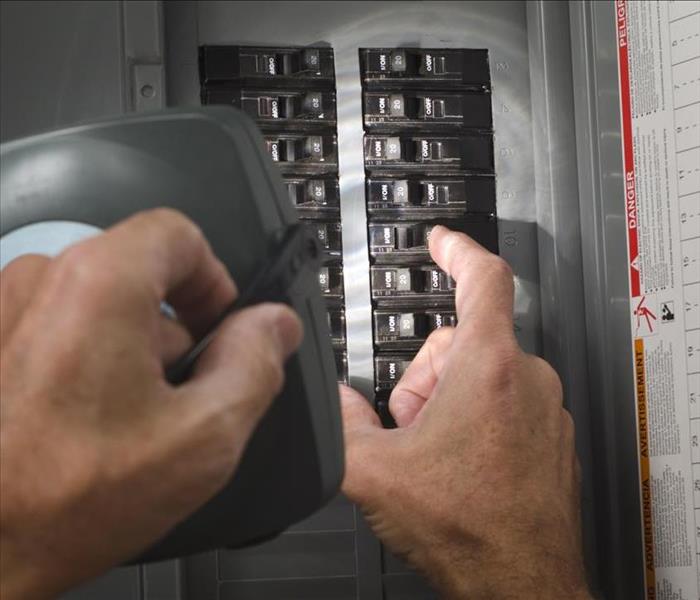 The greatest danger of a water damage situation is electricity. Be sure to shut down power to affected areas before work begins.
The greatest danger of a water damage situation is electricity. Be sure to shut down power to affected areas before work begins.
Standing water in your home can affect your property in ways that can be financially prohibitive to address as well as creating severe health issues. Any time there is flooding of any kind, water extraction needs to happen as quickly as possible. Water simply getting into your home in any way creates a serious issue but the longer water is allowed to stagnate, the more serious of a problem it creates. Here are four dangers associated with stagnant water.
1. Bacteria
Some of the most common health issues related to stagnant water are malaria, Legionnaires’ disease, and dengue. When water is clean, such as from a burst or leaky pipe, it doesn't start off containing bacteria but bacteria breed quickly, which means it can quickly become contaminated. Flooding that occurs as the result of storms or sewage overflows will generally already contain bacteria. The longer it sits, the more prevalent the bacteria become, creating a major health hazard. The longer water stands in your home, the more likely you are to contract a serious disease from it.
2. Mold and Mildew
Mold and mildew both have the potential to create a variety of health issues. Mildew generally has a strong odor, but mold will often be odorless so you may not even be aware of its presence. Mold spores are highly toxic, however, so if you have mold or mildew in your home, you will still feel the effects of it even if you can't see or smell it. One of the biggest dangers of stagnant water is that it allows mold and mildew to develop deep inside furniture or carpet padding or even inside your walls.
3. Risk of Injury
Waiting to have standing water extracted can pose a serious risk to those in the property. If circuit breakers are not turned off, there is the potential of being electrocuted. If the water is murky and can't be seen clearly through, there is also the risk of injuring yourself on unseen objects.
4. Structural Damage
Drywall works essentially the same way as a sponge does and is vulnerable to a process known as wicking. This is where the lower edges of the drywall will absorb water and transport it high up into the wall. Once it is there, it is generally hidden by the paint and even feels dry to the touch, so you may have no idea there is water in your walls. As the water dries, it will warp the drywall or even make its way into the wooden beams that form the support structure for your entire house. Once water works its way into the support beams of your home, it can wreak all kinds of havoc that can be very costly to fix.
5. Dry Rot
Dry rot is actually a fungus that produces spores which travel through the air. The fungus feeds off of the cellulose and hemicellulose in wood, which are the components which give the wood its strength. The mold spores need three things to grow into a fungus: heat (ideally between 70 and 77 degrees), moisture and a source of food (wood). When flooding occurs inside your home, it creates the ideal environment for the fungus that causes dry rot to develop. It is important to remember once again, that the entire support structure of your home is made of wood, which is largely hidden behind drywall.
Any time you have a flood, it is imperative that water extraction takes place as quickly as possible. Once the majority of the water has been extracted, however, it can still leave furniture, floors and even walls overly damp. This is why it is important to work with a professional restoration company. The moisture you can't see is generally what will do the most damage. A professional restoration company will not only take care of the water you can see but also the moisture you can't.
Causes of Residential Water Damage in Orlando
5/30/2019 (Permalink)
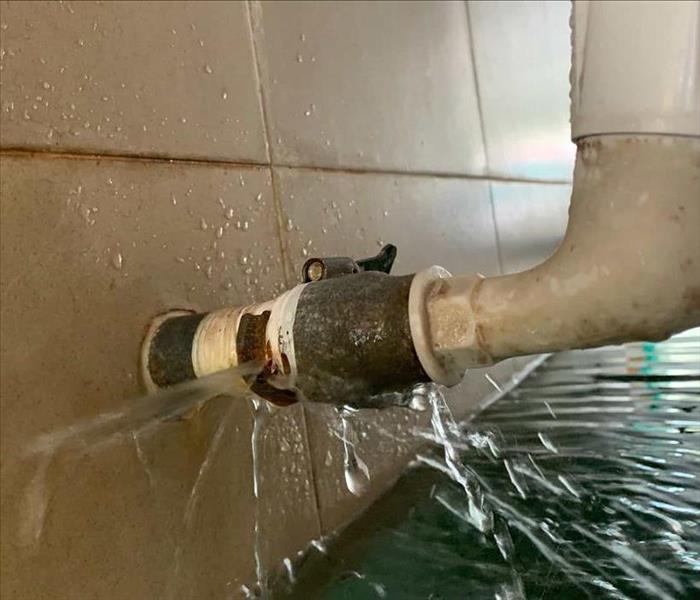 Pipe bursts and fixture leaks are a common cause of water damage in both residential and commercial properties.
Pipe bursts and fixture leaks are a common cause of water damage in both residential and commercial properties.
Water damage is a terrible event that can have devastating consequences for your home in Orlando if it is not properly and quickly addressed. This happens as excessive amounts of water start pooling up where it does not belong. There are a number of factors that can cause excessive water build up and resulting damage. They include the following:
- Plumbing system problems
- Leaking or burst pipes
- Water buildup in spaces that tend to gather water like residential attics, crawl spaces, and basements
- Issues with your HVAC systems (heating and air conditioning)
- Malfunctioning or defective appliances
- Natural disasters and ugly weather created problems
Once you are aware of the likely suspects causing this damage, you can take proper steps to head off floods and leaks before they get out of hand. The faster you recognize the issue, the less work the water extraction process will require. It will save you a great amount of damage restoration work and repairs as well.
Plumbing System Problems
It is true that occasional plumbing issues will happen behind the walls. You can not detect these when they occur. Many other issues start when pipe joints or hoses are not correctly attached. By taking an occasional look under your sink, you should be able to head off most serious plumbing issues. Clogged drains are another common cause of overflowing sinks, toilets, and bathtubs leading to water damage.
Leaking or Burst Pipes
Leaking pipes (or those which burst) are all too common causes of damage by water. Toilets and drains can back up, which causes a blockage. This leads to excess pressures on the pipes that respond by either leaking or bursting altogether. Improperly functioning garbage disposals are another frequent reason for why pipes can burst. Roots growing into sewer lines are yet another. Finally, if your pipes are rusty or simply old, this can cause them to leak over time.
Water Buildup in Spaces that Tend to Gather Water
Some places that lie hidden in your home have a greater tendency to suffer from accumulating water and resulting damage. This includes basements, crawl spaces, and attics. Crawl spaces themselves are built under houses so that workers can gain access to install electrical wiring and pipes.
The problem with this is that such damp and dark crawl spaces encourage mold to thrive. This leads to structural damage. Moisture that drips down through concrete foundations leads to basement leaks. Air getting in between the house and the attic causes condensation on the roof underside. This can create mold growth and rot. You should check around your house from time to time, especially accessible pipes.
Issues with HVAC Systems
HVAC systems include heating, air conditioning, and ventilating systems. They commonly cause water-related damage. If air conditioners are not routinely serviced, then this leads to a buildup of moisture. The cooling moisture encourages mold to grow in the ducts of the air conditioning system.
Malfunctioning or Defective Appliances
Appliances age with time, causing the piping to rust and the hoses to weaken. This includes refrigerators, washing machines, dishwashers, and water heaters that can all be subject to deterioration. You should closely watch machines that are older. Hot water heaters and washing machines are generally the two appliances that create this kind of damage in a house.
Natural Disasters and Ugly Weather Created Problems
You can not control natural disaster borne water issues. But you might undertake all necessary preventative safety measures before they strike to mitigate their impacts on your house. Hurricanes, flash floods, and unexpected storms all lead to damaging water buildup. Clogged rain gutters, roof damage, and cracks in the foundation are common causes of water damage during bad weather.
The Water Removal Process
Fortunately, there is a process of water extraction that can remove nearly all of the water in your Orlando home. Professionals like our staff at SERVPRO Winter Park can decrease the drying time to stop mold or additional water damage from occurring. We utilize truck mounted vacuums and potent pumps in order to rapidly take away from hundreds to thousands of gallons in excess water.
Step One: Pack Out
Should your house require an extensive cleanup and restoration job, our professionals will efficiently move you out to save your belongings from suffering from additional damage.
Step Two: Emergency Water Removal
Expertly trained water removal techs will start removing water almost right away. They could utilize submersible pumps along with industrial grade wet/dry vacs. This crucial step will reduce the amount of time needed to dry the house and aid in heading off secondary water damage and mold before it begins.
Inspect Carpets and Carpet Pad
Our pros will investigate the damage to the carpet and its pads to learn if they need to be taken out to save the sub-floor. We use such detection equipment as hygrometers, moisture detectors, and meters to ascertain the moisture saturation levels. We could utilize infrared cameras to locate that hidden water lurking behind ceilings and walls. Gas powered and submersible pumps do this job of constantly pumping away high levels of water. Our portable and truck-mounted extraction units will ensure effective water removal.
Dehumidifying and Drying
It is possible that once the water has been removed, your residential walls and floors may appear dry but still feel wet when touched. This is because, unfortunately, the majority of building materials (including wood and drywall) retain large amounts of water. This will warp, break down, or swell the material and lead to mold damage as well. It is where the dehumidifying process begins.
Our Orlando experts will manipulate humidity and temperature levels to dry the remaining moisture. We utilize particular equipment ideally suited for this, such as dehumidifiers and air movers. This will get out that water that has been retained. The high-speed air movers will cause an airflow over carpets and pads, furniture, and walls to evaporate the moisture. Our Orlando experts will closely monitor the progress by utilizing moisture meters to determine the point where all materials have reached necessary drying levels.
Tips for Water Damaged Furniture
4/17/2019 (Permalink)
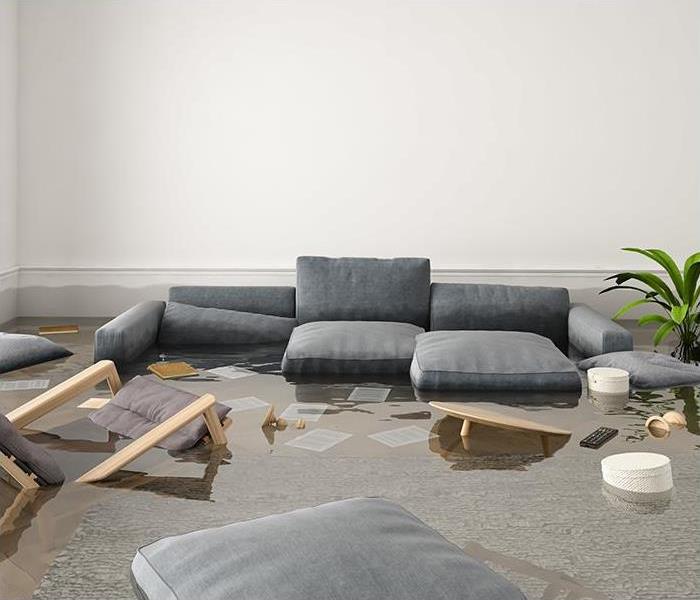 Flood water is considered to be black water. Because of dangerous toxins and materials, it is recommended to throw these affected items away.
Flood water is considered to be black water. Because of dangerous toxins and materials, it is recommended to throw these affected items away.
Furniture that gets wet is not a pretty picture. Important questions that arise when you suffer from such a disaster in your home include: Can you save the furniture and how can you save it? The first critical step with any form of water damage involves determining the levels of risk factors in the contaminating water. This refers to the amount and types of pathogens that are found in the water. It is critical to make sure that a disease will not be contracted from exposure to the water.
The 3 Types of Contaminating Water
The first step is learning from which type of water your furniture has suffered damage. There are three types of water that can cause damage to your furniture. These are as follows:
- Category 1 - Clean Water - the drinkable water that comes from the regular pipes in your home. You could drink this, and it poses no threat to your family's health
- Category 2 - Grey Water - there are some contaminants found in greywater from either biological or chemical agents. These could be from the leakage of a water heater, an overturned fish aquarium, or an overflowing washing machine. While it will not kill you, you would not want to drink the water or get it in your eyes, which could easily burn on contact.
- Category 3 - Black Water - this is really nasty water including sewage or runoff from a river. It could make your family terribly ill. You should neither come into contact with it or even breathe the air surrounding the water.
How Furniture Items Can Be Cleaned
It is important to determine the water category to learn the proper path for cleaning the water damaged furniture. There are many cost-effective methods for treating the first and second categories of water damage. When black water has infected the furniture it usually cannot be saved. Methods of treating furniture vary according to whether it is wood or upholstered.
Wood Furniture
Wood suffers from water damage very quickly. When it is on a large scale it becomes more serious as wood furniture is tricky to fix. If you allowed the furniture to sit in water for several days, it is likely completely ruined and should be discarded. For one thing, the bindings or glue that hold it together may be irreparably damaged.
Yet even still it might be saved. You can take pieces apart to clean and dry them before putting them back together. The furniture will generally require re-stripping, bleaching, cleaning, drying out, and refinishing. This will be both a labor and time-intensive process. It is wise to get a cost estimate done before you start the project to ascertain if it makes more sense to restore an original piece or replace the furniture entirely.
Upholstered Furniture
Upholstered couches and chairs are sometimes tricky to dry and clean. The items may be pressure treated in a special way. Extremely high-temperature water will first kill off pathogens such as bacteria. After the furniture has dried properly it will be put in a room with a dehumidifier and air movers set up.
Such air movers will be strategically placed to move dry, hot air through and over the furniture. The moisture will evaporate, and the industrial dehumidifier will gather in the moisture. It will finally be released outside of the house.
There are circumstances where the upholstery has to be removed. These include when the water has soaked into the furniture over a long period of time. Cleaning, then a treating and drying process will reach the places that are hard to get to which have become water damaged.
When Items Should Be Disposed Of Finally
It is critical to realize that you can not hope to clean out water damaged furniture which has been soaked by the black category 1 water damage. There are cases where it could be sensible to try if the piece was very expensive (like with a Persian rug). The costs of trying to do this generally are far greater than simply replacing the items. This is true for most any kind of porous-surfaced furniture. The best plan is to take the black water damaged item and simply throw it away.
For furniture that is upholstered and heavily damaged by other categories of water, there are limited options. Fabric that has become watermarked or stained is difficult to completely restore. It is possible that after a few hours of soaking in water, silt and mud can penetrate the padding and fabric as well.
Padding also still holds in water even when the rest of the furniture appears dry. This is when mildew forms outside and inside. Wood that is finished will turn cloudy. The wood can mildew if the flood water manages to penetrate the finish. Joints within wood frames can also become loose. If the furniture was sewage-contaminated or has industrial chemicals or pesticides from the flood water within it, this is the time to throw away the upholstered or wood furniture and start over with new pieces.
Water Heater Leak Cleanup in Winter Park
4/15/2019 (Permalink)
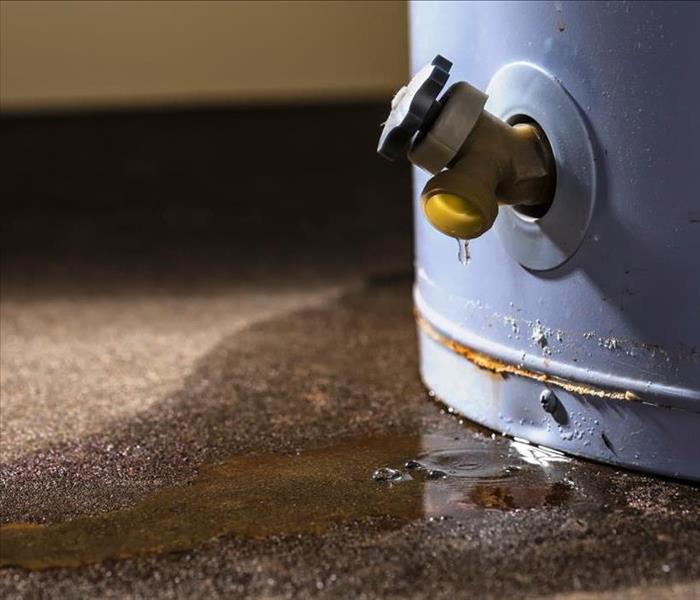 Make sure to clean up and dry as much water as possible to prevent further damage.
Make sure to clean up and dry as much water as possible to prevent further damage.
If you have recently experienced a water heater leak, there are several simple steps you can take to clean up the leak and minimize safety risks. Try to limit the extent of the leak as soon as you notice a leaking water heater. Contact a plumber to fix a broken water heater or replace a failed water heater, and then determine the extent of the water damage. Follow these four steps to address the leak. For complete peace of mind, especially with a larger leak, you should contact a company that provides water damage restoration in Winter Park.
Electrical Appliances
Unplug electrical appliances in the affected area. You don't want to risk electrocution or other appliances being adversely affected by a leak.
Removable Items
Remove soaked carpets and moveable items from the area surrounding the leaking water heater. You may be able to dry out some items, but carpet may not be salvageable.
Drying the Area
Dry the floor as soon as possible. You can use a mop, towels, or a wet-dry shop vacuum to remove excess water. You can also use a desiccant such as silica gel near soaked floors or walls.
Circulate air and dehumidify. This will speed the drying process and limit the extent of the water damage while making the environment less conducive to mold growth.
If you notice a leaking water heater in your home while the leak is still small, you may be able to limit the extent of the water damage by taking immediate action. If the leak is larger or has gone unnoticed for more than 24 hours, you should contact a residential restoration service in Winter Park, FL. Either you or damage restoration experts will need to clean up and dry all the water to prevent mold. Make sure to also have a plumber replace a failed or broken water heater to prevent another leak.
Water Extraction Company
4/1/2019 (Permalink)
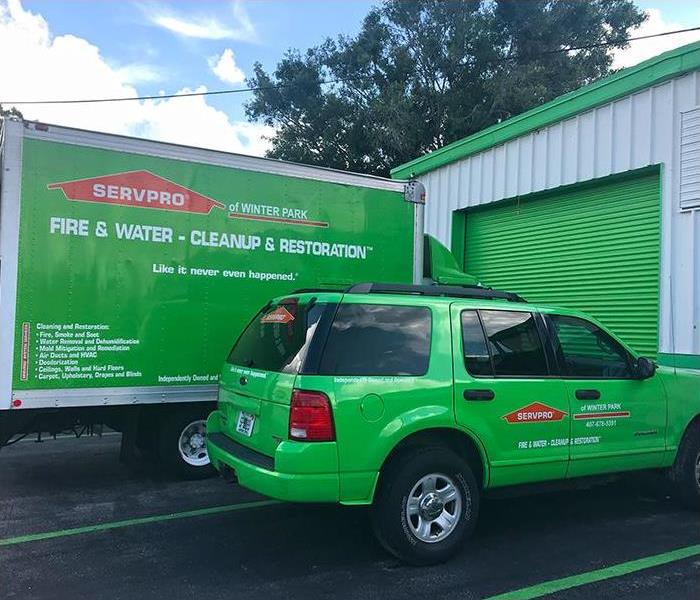 We are conveniently located in Winter Park just north of Downtown Orlando and can mobilize quickly to start extracting water!
We are conveniently located in Winter Park just north of Downtown Orlando and can mobilize quickly to start extracting water!
It can be hard to believe that water is the most powerful and destructive element in an indoor environment. Yet flooding and excessive moisture can easily lead to structural damage and destruction of personal property as well. Such issues can become very serious indeed if the water clean up is not done quickly and the water becomes unsanitary.
The Importance of Having Water Quickly Removed
Reducing the harmful side effects of indoor water can be done through efficient and quick intervention. The first 24 to 48 hours are crucial. Water damage may look hopeless to fix, but quick response cleanup, drying, and restoration can yield simply incredible results.
The good news is that a water extraction process will remove this damaging water from your home or office. When you trust our water extraction company professionals at SERVPRO of Winter Park, you will have your drying time decreased to stop secondary water damage and mold from taking over. Our professionals utilize truck mounted vacuums and powerful pumps to rapidly pull out large amounts of water from your property.
The Negative Effects of Leaving Water Damage Unattended
There are various negative side effects that your property will suffer from if you do not quickly address the results of water damage indoors. One of the most severe is the formation of potentially toxic mold. Mold is a terrible problem that you have to stop before it gets started in earnest.
There is not much time to stop the growth of mold. This is generally a matter of only hours, never days or weeks. In order to stop mold from developing, you have to count on a rapid response from a water damage and restoration contractor that is professional and quick. While it is true that seriously perilous molds do not form every day, any such mold can create health problems. This is why effective mold removal should be done as soon as possible.
Restoring your property is more science than art. We look at three crucial criteria to determine if your personal property needs to be replaced or can be instead restored. These are the following:
- The quantity of damage to your property
- Contamination degree of the property
- Restoration costs versus replacement costs involved
Not dealing with this critical water damage upfront can also lead to serious interruptions in business for commercial properties, possible negative health risks, and increased financial burdens later.
How Our Water Extraction Process and Methods Work
The water extraction process starts with you making emergency contact with our company. SERVPRO of Winter Park will send out an inspection team of highly trained technicians. They utilize equipment including hygrometers and moisture detectors with other meters in order to determine the extent of the saturation. The team may also utilize infrared cameras so that they can locate any water (that is not obvious) behind ceilings and walls.
They go straight into the third step of water removal practically immediately. The amount of work involved and the process varies according to how much water is on your property. In cases where there is a lot of water, they might utilize potent submersible pumps to suck up excess water before turning to standard industrial wet and dry vacuums. These gas powered pumps will allow water to be constantly pumped out at a rapid rate and level. Units can be portable and truck mounted. In both cases, they efficiently deliver water removal fast. This way, we are able to decrease the amount of drying time so that you can avoid secondary water damage and stop mold from forming in the first place.
After the fourth step of drying is completed, we move on to step five sanitizing and cleaning. The final step six centers on the actual restoration work.
Using SERVPRO Over Smaller Water Damage Companies
There are a variety of reasons why you would want to work with a trusted bigger brand name company like us at SERVPRO rather than one of the smaller water damage firms. This starts with our ability to immediately respond and begin the water removal work. You simply can not afford any delays from when you call the contractor to when they respond, or you will have more problems and potentially greater damage. All water restoration companies may claim to be emergency providers, but few can deliver on that pledge. Our company will generally respond in an hour or less.
A bigger company like ours also has enough manpower and equipment available to not only quickly begin, but also to rapidly finish the job. We specialize in delivering such rapid water removal services so that we can get your property entirely dry quickly.
Another advantage of a larger and better-established company is that we can offer fast and accurate estimates and insurance company billing. Not only are our estimates quick and easy to get, but our project manager and inspection team will come out as fast as possible to put together a complete work proposal so that you know our price quote in advance of beginning the water removal and cleanup.
If you are covered in a flood or water damage insurance policy, then this will help you with the costs. Rather than have to pay upfront and wait for a claim to be reimbursed, we are able to dispatch the bill straight over to the insurance company. This saves you from having to pay upfront to begin the work. It removes the hassles from upfront billing and the later reimbursement paperwork and process.
Finally, a larger, more reputable firm like SERVPRO will offer completely guaranteed services. There are any number of poor quality contractors in this business. It is easier for them to keep operating as their services are usually paid for by insurance, not the customer. It leads to greater instances of poor quality workmanship, unfortunately.
Making sure that you get the best service possible, we offer an upfront guarantee. You will be 100 percent satisfied with our work when we complete the water cleanup services. Our job is not completely done until you are fully satisfied.
How Water Damage Affects Carpeting in Your Orlando Home
7/27/2018 (Permalink)
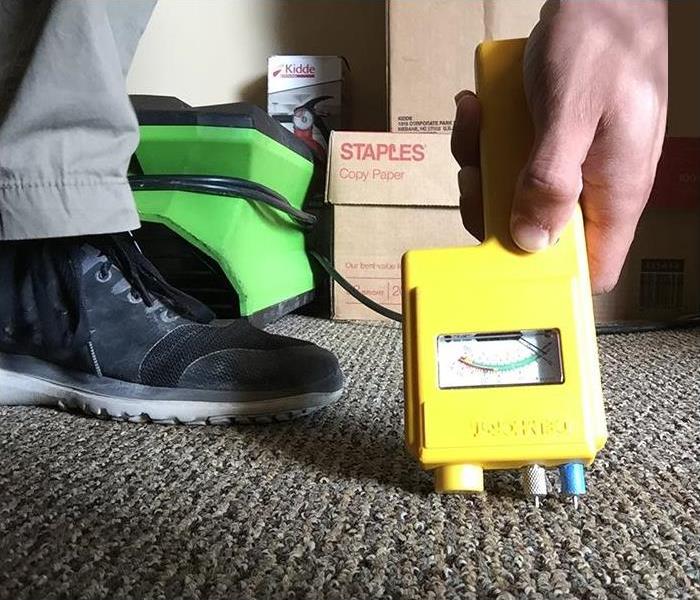 Our before and after tests determine the amount of moisture in your carpet and ensure it is completely dried when we are finished.
Our before and after tests determine the amount of moisture in your carpet and ensure it is completely dried when we are finished.
When a pipe bursts or water enters your Orlando home through faulty roofing, the water will follow gravity as it flows into your home. If your home has carpeting, it is important to know how water damage can occur in the event of a water disaster. Carpet fibers are porous so water can soak into the material and hold moisture. If carpeting gets saturated, glues can weaken causing the backing to peel away from the fibers.
Padding and Subfloors Can Also Be Affected
Carpet can also hold in moisture causing microbes to develop on the surface of the subfloor underneath. When mitigating water damage in Orlando, our SERVPRO technicians take extra measures to save carpeting materials. When the padding underneath the carpet gets wet, it can disintegrate and fall apart. Pad often gets removed and replaced since it is typically inexpensive to install.
How Moisture is Removed
We follow a water repair process that is proven to work and do not cut corners to save time at your expense. The first step in removing moisture from carpet is to extract it using specialized equipment. Either a portable or truck-mounted extractor gets used to pull water into a disposal tank. Industrial strength wands are applied to the wet carpet and are connected to the water extraction equipment. Extracted water travels from the extractor to the truck mounts where it is kept until properly drained elsewhere,
After extraction is completed, drying equipment gets set up to dry out the carpet inside your apartment. Air movers push air in a circular motion speeding up the evaporation process. Dehumidifiers then get utilized to pull moisture out of the environment and lower the property's relative humidity.
In some cases, the carpet gets extremely wet and the subfloor underneath also gets affected by moisture. In situations like these, our SERVPRO water damage restoration technicians pull up the carpet and place an air mover underneath it to float the flooring material drying the floor covering from underneath while drying the wooden subfloor at the same time. Once moisture levels in both affected elements return to what they were before the loss occurred, the air movers get removed.
Professional Water Damage Services
Before we finalize the project we use carpet tools to put the material back into the same condition, it was before drying procedures took place. The last step usually involves cleaning the carpeting with disinfectant solutions. If you ever need help dealing with wet floors, call SERVPRO of Winter Park at (407) 678-5391 24 hours a day.
Water Damage Timeline Following a Disaster
6/20/2018 (Permalink)
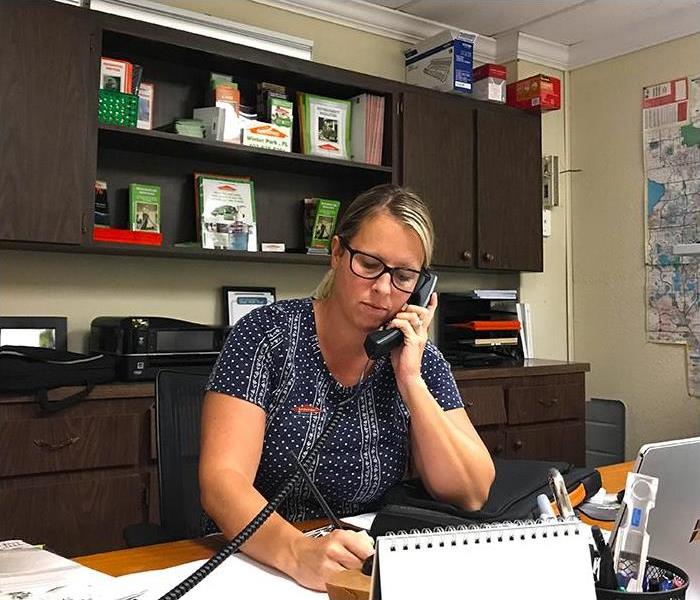 SERVPRO is available 24 hours a day and 7 days a week to take your emergency water damage call!
SERVPRO is available 24 hours a day and 7 days a week to take your emergency water damage call!
Flooding and water damage can occur for a number of reasons and can happen very quickly with very little notice. SERVPRO of Winter Park arrives quickly and starts the water extraction process for your property almost immediately. This prompt response helps to minimize the damage and the cleaning and restoration costs.
Within Minutes:
- Water quickly spreads throughout the property, saturating everything in its path.
- Water is absorbed into walls, floors, upholstery, and belongings.
- Furniture finishes may bleed, causing permanent staining on carpets.
- Photographs, books, and other paper goods start to swell and warp.
Hours 1 - 24:
- Drywall begins to swell and break down.
- Metal surfaces begin to tarnish.
- Furniture begins to swell and crack.
- Dyes and inks from cloth and paper goods spread and stain.
- A musty odor appears.
48 Hours to 1 Week:
- Mold and mildew may grow and spread.
- Doors, windows, and studs swell and warp.
- Metal begins to rust and corrode.
- Furniture warps and shows signs of mold.
- Paint begins to blister.
- Wood flooring swells and warps.
- Serious biohazard contamination is possible.
More Than 1 Week:
- Restoration time and cost may increase dramatically; replacing contaminated materials and structural rebuilding may be extensive.
- Structural safety, mold growth, and biohazard contaminants pose serious risks to occupants.
About SERVPRO of Winter Park
SERVPRO of Winter Park specializes in the cleanup and restoration of residential and commercial property after a fire, smoke or water damage event. Our staff is highly trained in property damage restoration. Give us a call if you have any questions (407) 678-5391!
7 Orlando Water Damage Restoration Tips
5/31/2018 (Permalink)
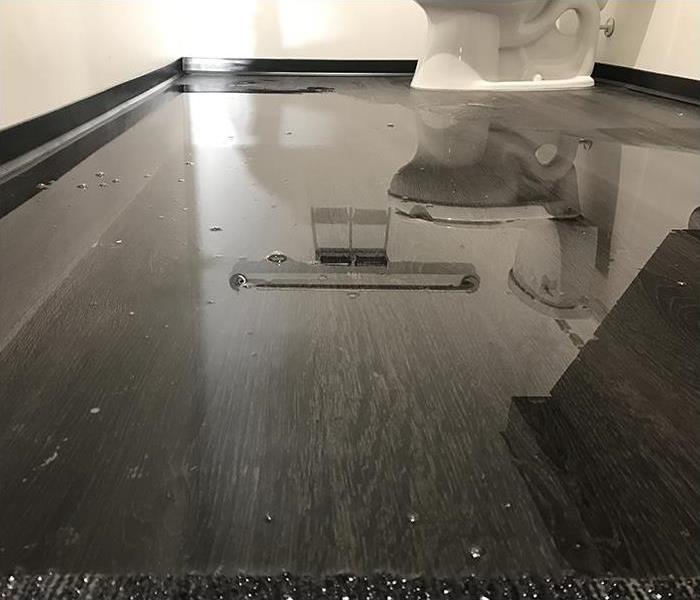 You can speed up the overall Orlando water damage restoration process by using a mop or towel to remove standing water from the affected area
You can speed up the overall Orlando water damage restoration process by using a mop or towel to remove standing water from the affected area
Experiencing water damage in your home or commercial business is a stressful situation. If you have made the choice to contact SERVPRO of Winter Park, a professional Orlando water damage restoration company, then rest assured knowing you have made the smart and right choice. The professionals know exactly what to do to correct a water damage situation and prevent further damages, however, there are steps you can take to minimize damage even further while you wait for your technician to arrive. Here are some ways you can help the process.
1. Safety
Keeping yourself and other inhabitants safe during a water damage is the absolute best way you can help yourself and your restoration company. It is very common for slips, falls, and electric shocks to occur during these situations. Also, be wary when attempting to lift objects, as soaked contents tend to weigh much more and can even cause bodily injury. Safety should be your first thought when handling any tasks so that a bad situation does not become a worse situation.
2. Water Source
Our team is fully capable of extracting large amounts of standing water upon arrival, however, the duration of this process can be much shorter the sooner the water source is shut off. Doing so promptly can also minimize the extent to which your property and contents are affected. In most cases, the water shut-off valve is located either in your garage, utility room or outside your home near the water meter.
3. Electrical
To avoid possible electrical shock, it is always a best practice to shut off the source of electricity to the affected areas of the property. Locate the breakers and read the manual, usually attached to the inside of the breaker panel, to shut off power to the correct areas. Also, if possible, refrain from using anything electrically powered near the affected areas as wires and other components may be wet as well.
4. Air Conditioning
Mold growth in Orlando is extremely common and oftentimes occurs at an accelerated rate due to the humidity of Central Florida. Part of our water damage restoration process is to make sure all components get dried out so there is no moisture. You can also help prevent mold growth, by keeping your air conditioner running until help arrives to keep humidity down and even help contents to begin drying.
5. Floors and Carpeting
While help is on the way to your property in Orlando, you can expedite the process by removing as much standing water as possible. Using a mop or towels can help bring down the amount of water. Be careful not to spread the water to other areas while doing so. If the affected area is a soaked carpet, you may also remove soaked Oriental rugs from the area and blot the soaked wall to wall carpet with towels.
6. Fabrics and Clothing
Remove any fabrics and clothes from the area and transfer them to a dry area. Also, make sure that drapes and curtains do not stay in contact with your wet floor or carpet.
7. Furniture
To avoid more damage, remove any light pieces of furniture from the area and dry them to the best of your ability. Discuss these contents with your technician when they arrive so they can check them for moisture as well. If possible, try to elevate any furniture that can not be removed. If elevating furniture is not an option, another trick is to place plastic bags or plastic wrap under the legs of heavy furniture to limit their contact with the water.
Need Water Damage Restoration in Orlando?
SERVPRO of Winter Park is an Orlando water damage restoration company that has years of experience with situations like yours. We pride ourselves on providing fast, reliable, and trustworthy water restoration services to our community. If you have a water disaster, make sure to choose the restoration company you can trust. Our phones lines at 407-837-8990 are open 24/7 to assist you with your emergency. Give us a call today!
Orlando Water Damage Companies
4/21/2018 (Permalink)
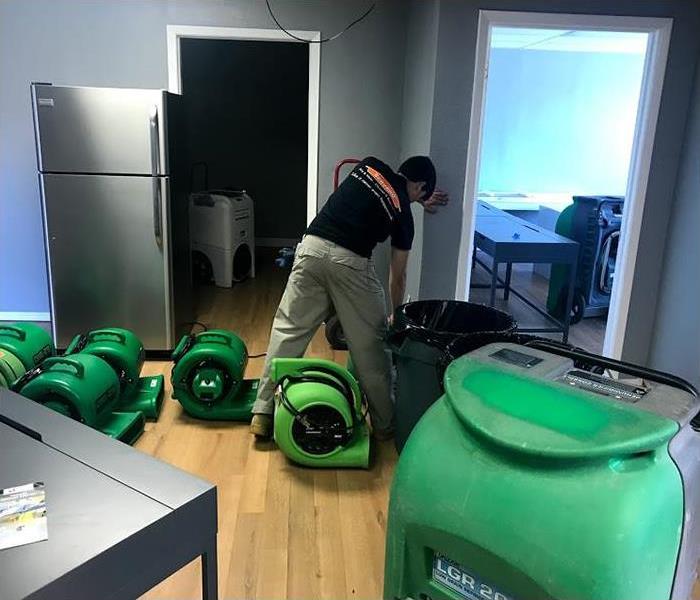 Our technicians are trained to use the best equipment available to restore your property.
Our technicians are trained to use the best equipment available to restore your property.
One of the main disasters affecting residential and commercial properties in the USA is water damage. For the Orlando area, the most common cause of water damage is severe flooding. SERVPRO of Winter Park specializes in incidences like burst water pipes, floodwater, and many other causes.
Any type of water damage encountered in the Orlando, FL area should be immediately seen to by a professional expert in the Orlando water damage restoration industry. At SERVPRO of Winter Park, our team consists of highly trained and experienced staff. Our expert teams go through a proven step by step process for rectifying your problem and getting you back into your property. Our water damage restoration process has been proven effective for many years and results in the fastest turnaround times to get people back into their homes or businesses.
Safety
Safety should not only be a priority for you, but for your restoration company of choice as well. The best Orlando water damage professionals understand the importance of safety and the health risks of everyone involved when safety precautions are not taken. Make sure the services provided are thorough. For example, baseboards should be pulled to ensure there is no excess water trapped behind them that could lead to mold growth. Many times, mold is already present during water extraction jobs where the damage happened a few days or more prior. In these cases, your restoration company should be doing everything possible to prevent mold spores from being disrupted and spread further throughout the property.
Reliability
The SERVPRO brand and reputation has been built over years and all our customers have complimented our reliability. At SERVPRO of Winter Park, we stand by our reputation as a reliable water damage restoration company by setting clear expectations before jobs are started. We communicate with our clients throughout the entire process, keeping our clients informed, answering questions, addressing concerns, and making good on our promises. Returning you and your property to the state it was immediately prior to the flooding occurring is how we ensure full satisfaction in every possible situation.
Distance from Property
It is important to hire a restoration company that is near in proximity and can arrive on scene quickly whether during an initial emergency call or routine visits throughout the process. Our SERVPRO franchise is physically located in Winter Park, however, we service the Orlando area as well and utilize the many access routes to place us on the scene at your property in a timely fashion.
Professional Certifications
As a registered and fully certified company, SERVPRO of Winter Park is always striving for excellence and improvement in processes to ensure that you always enjoy excellent service with our dedicated response teams. We keep up with the evolution of technologies and processes to make sure that we use the newest resources and techniques available to make your restoration job a full success.
Satisfied Customers
No disaster is a fun situation for our clients. During this highly stressful time, we do our best to ensure a smooth process and meet our clients' goals while maintaining high standards. We pride ourselves on making a water disaster “Like it never even happened”. We keep noise to a minimum and try to respect the need for accessible pathways for employees or residents.
A good practice to keep when searching for a restoration company is looking at their public reviews. Let a company’s past clients paint a picture of what your services with them may look like. There is something to say about a client who’s disaster situation was taken care of so well that they took to an online platform like Google or Yelp to let the public know about their experience.
If you are in a situation that requires an Orlando water damage repair company and you want to make sure that your problem is dealt with in the best possible way, then give us a call at (407) 678-5391 any time of day no matter how severe the problem is.
Water Damage and It's Hidden Signs
4/13/2018 (Permalink)
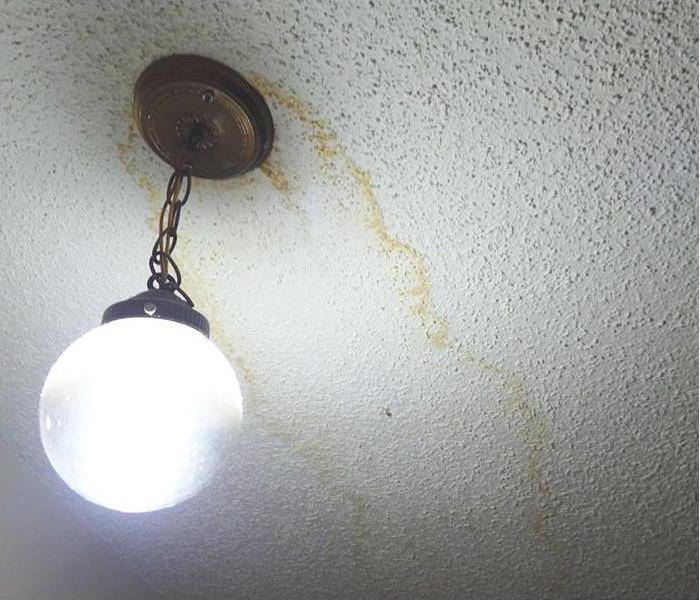 Watermarks and stains are a sign of a previous or existing leak.
Watermarks and stains are a sign of a previous or existing leak.
Water damage is one of the last things any property manager or homeowner wants to deal with. Unfortunately, the weather in Central FL cities such as Winter Park and Orlando is known for its spontaneous rain and storms. Couple this with the fact that any facility, whether residential or commercial, must have a substantial supply of water and a clearer picture of how likely a water disaster can strike is painted.
A few examples of how water damage can occur on a property are sewage overflow, ruptured water pipes, water heater leaks, dishwasher malfunctions, or in many cases flooding from a severe storm or hurricane. Aside from the visible or obvious causes of water damage, what many homeowners and property managers may not notice are slow leaks and/or plumbing issues that can quietly damage a property.
Knowing the signs of hidden water damage will better equip a building or homeowner to detect leaks that can lead to damage or even discover if a property has suffered from water damage in the past.
Signs of Hidden Water Damage
- Wallpaper and Paint - If a wallpaper adhesive is used on the property, check for signs of peeling. In properties with interior paint, a water leak behind a wall may cause raised and wavy lines.
- Baseboards and Trim - Look for baseboards and trims that are separating from the wall. Exposure to water may cause swelling over time, which may push the baseboard from their flush placement against the wall.
- Wooden Furniture - Wooden furniture may swell if exposed to water for a prolonged time.
- Bathroom Tiles - Check the floor tiles around your toilet for darker colored grout. This is a sign of a leaking toilet.
- Unexplained Moisture - If a pipe ruptures in your concrete slab, it can slowly lead to warped floorboards, cracked tile or damp carpet if the right amount of water is soaked up by the under-padding.
- Sweating Walls - Blotches of condensation are a common sign that excessive moisture is festering behind the walls. This can be caused by a leak or a mixture of high humidity, poor ventilation and/or inadequate insulation.
- Mold - Any presence of mold or mildew is a solid sign that an area has been exposed to water and the right amount of humidity for at least 48 hours.
- Watermarks and Stains - Ceiling marks and stains, commonly seen in office buildings, are a sign of a previous or existing leak.
- Swollen Door Casing – Water leaks can cause an exposed door casing to swell and become unaligned. A door that begins to have trouble opening and closing could be a sign of a leak.
Keep these hidden signs of water damage to your property in mind to be better prepared and aware if a water disaster strikes. Should you notice a sign of damage, hidden or visible, SERVPRO of Winter Park’s phone lines are open 24/7. Our experts in the restoration field can perform an in-depth water damage assessment to ensure our restoration services are successful. To speak to a water and mold expert, give us a call at 407-678-5391.
Water Damage Restoration Process
2/16/2018 (Permalink)
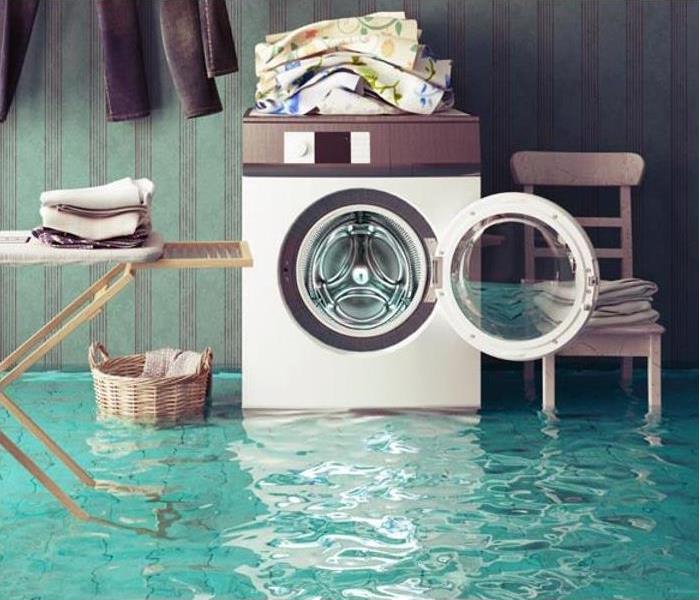 Washing machines are a common cause of water damage.
Washing machines are a common cause of water damage.
Some common causes of water damage in Florida are air conditioning units, excess humidity, and lots of heavy rain showers. AC units typically run on a daily basis for the duration of the year. Other causes include overflowing washing machine units, backed up sewers, hurricanes and storms, and lakes and rivers in close proximity. Quick action following any water damage is important because each of these issues can create the perfect environment for mold and mildew.
Trained Water Damage Specialists
Quick action is also the most important step in your water damage claim. By calling SERVPRO of Winter Park, we can have our water mitigation experts onsite within an hour. Our experts begin the dry-out and repair process to restore your residential or commercial property as fast and efficient as possible. All of our specialists are completely trained and use the most advanced equipment and techniques in the industry.
Our Restoration Process
No two water disasters are the same. Every factor can vary from the amount of water to level of contamination. The steps below show our process for the more common typed of water-related emergencies.
1: Emergency Contact
2: Inspection and Damage Assessment
3: Water Removal/Water Extraction
4: Drying and Dehumidification
5: Cleaning and Repair
6: Restoration
We Are Here to Help
SERVPRO of Winter Park is available 24/7 to respond to your water and mold emergencies. We are Faster to Any Size Disaster! Give us a call at 407-678-5391 to have one of our water mitigation experts assess the damage to your property.
Water Damage to Fabrics
9/6/2016 (Permalink)
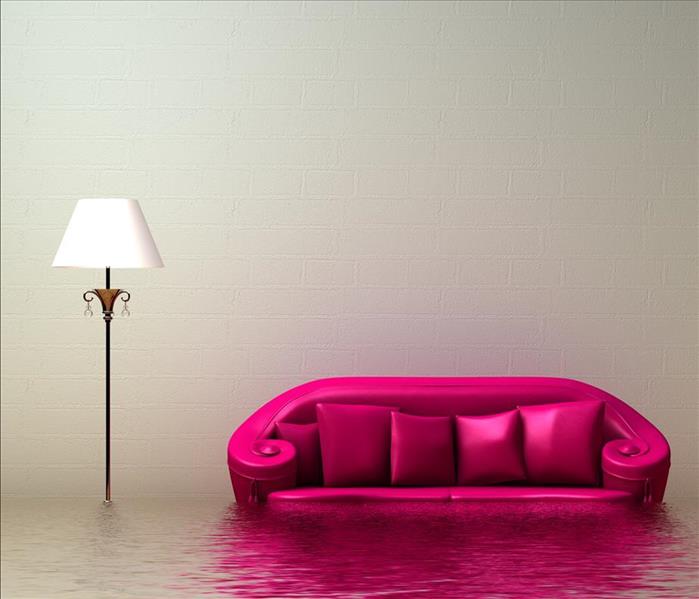 Water Damaged Sofa in Orlando? Let SERVPRO Help.
Water Damaged Sofa in Orlando? Let SERVPRO Help.
SERVPRO Can Salvage Fabrics from Water Damage
Some of the most at-risk objects and materials in a home come in the form of fabrics. Fabric and textiles make up our furniture, our flooring, drapes, our belongings, and sometimes even our walls and appliances, and all of these are highly susceptible to water damage. Thankfully, most types of water damage to fabrics are restorable and treatable in the hands of trained professionals. Depending on the type of fabric and its use, we vary our approach considerably when taking on a job for water damage restoration to fabrics.
Issues in General
Common throughout most types of fabric taking on water damage in Orlando are a few constant problems. For homeowners, the most troubling are often staining and discoloration, which can permanently ruin the appearance of some types of fabric if not treated correctly. Depending on the kind of water damage and fabric, our technicians may be able to remove this staining without replacing anything.
Carpeting
When it absorbs water, carpeting and padding can become heavily warped and misshapen. If not treated quickly, this may lead to a complete replacing of the material. Furthermore, carpeting is often harmed through flooding, which means that the general fabric damages are often most dangerous and prominent here. However, if only a portion of the carpet is too far gone, it can typically be removed and replaced if a successful drying out of the remaining carpet and pad has been accomplished.
Drapes and Window Coverings
Drapes and window treatments can also sustain water damage through flooding, but are also a common casualty after storm damage. If the damage is significant, it can be difficult to fully restore large and heavy drapes, although damage is often light enough to allow for full restoration.
Furniture
Fabric furniture pieces can sustain all of the usual problems, but are also highly susceptible to color bleed. Following a flood or significant water wicking into a piece of furniture, we recommend removing all pillows, sheets, and cushions from the furniture, if possible. This may help to mitigate damage to the non-fabric portions of the furniture.
Clothing
Most articles of clothing can survive light to moderate water damage with a thorough dry cleaning. For heavier damage or flooding, however, it is typically best to replace most items, as they may present a hazard or be too costly to restore.
SERVPRO of Winter Park is an experienced and well-staffed home restoration and cleanup service provider which has helped dozens of local home and business owners to get past even the worst catastrophes. For our services or a quote, call us 24/7 at (407) 678-5391.
SERVPRO For Reliable Restoration Services
4/28/2016 (Permalink)
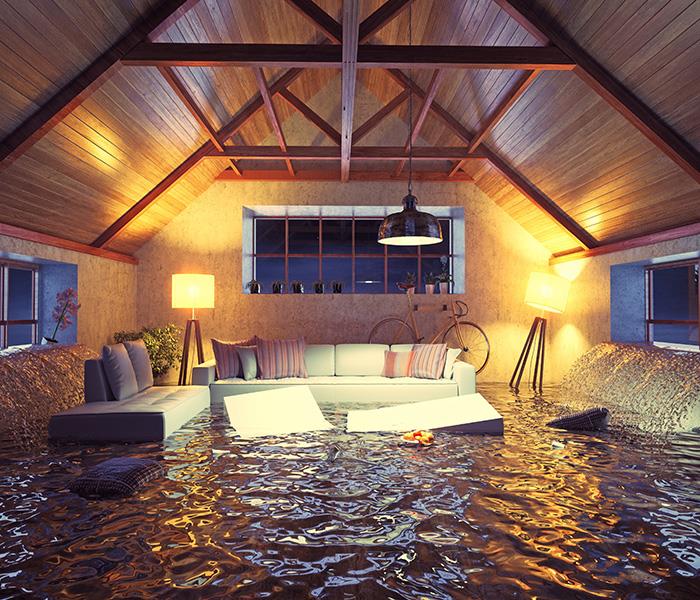 When you are dealing with the aftermath of College Park water damage to your property, you will need to call upon the assistance of professionals.
When you are dealing with the aftermath of College Park water damage to your property, you will need to call upon the assistance of professionals.
Call SERVPRO for Water Damage Cleanup In College Park
Water damage to your College Park property, you will need to call upon the assistance of a professional cleanup and restoration service. Whether the damage is due to a burst water main, sewer system malfunction, or flash flood, it is always best to address the damage and repair it as soon as possible.
A Fast Response to Your Emergency Situation Is Crucial
It is highly important that the professionals hired to take care of the job respond to your emergency in a prompt and professional manner. As soon as they arrive at your property, they will begin an immediate inspection of the damaged areas and then offer you a professional assessment of the work that needs to be performed.
Once the initial examination and evaluation are completed, the primary objective is to clear out all of the remaining water from your property. This process begins with the removal of all of the water that is standing in your house, collecting in pools and causing bacterial and other damage. The method also includes fully vacuuming your home and repairing any cracks and crevices where water can collect unseen and potentially cause further damage months or years down the road.
After all of the water has been removed from your property, they will then proceed to remove all of the debris and other foreign matter that may have collected on your property as a result of the emergency. Once the waste cleanup is complete, the professionals should be able to remove all remaining odors and other residual sources of trouble to make your property completely secure for you and your family to live in again.
SERVPRO of Winter Park Can Help You Deal With College Park Water Damage
When you need a prompt response to your emergency situation, it makes sense to call a local restoration service to get a timely and efficient response. Our team is available to residents in the entire metropolitan area, including College Park, Orlando, Maitland, Thorton Park, Baldwin Park, Oviedo, and Waterford Lakes. You can feel free to contact us at any time with any questions, comments, or concerns you may have regarding our property restoration services. When it comes to dealing with College Park water damage, it pays to call upon a professional provider of property restoration services. When you need a fast, cost effective solution to your water damage crisis, we have the knowledge, skills, and experience to be of service to you. Contact SERVPRO of Winter Park today at (407) 678-5391.
Dont Wast Money Water Damage Requires Immediate Treatment
3/7/2016 (Permalink)
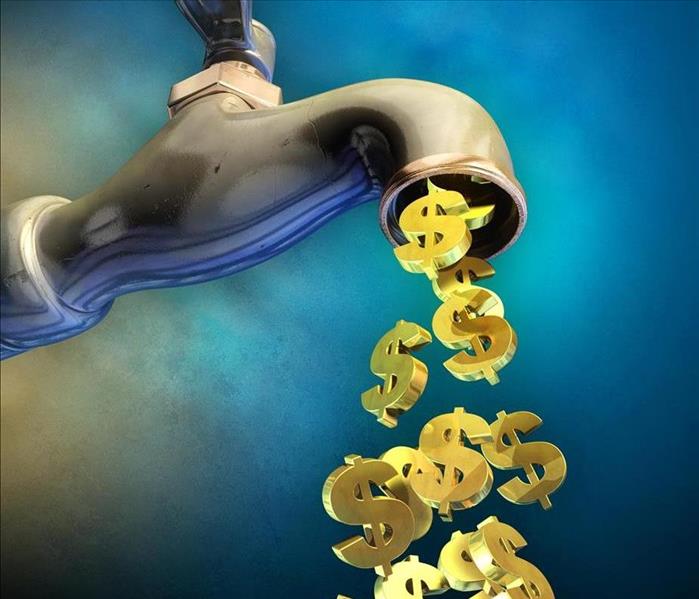 Don't Waste Your Water and Money on a Leak, Call SERVPRO
Don't Waste Your Water and Money on a Leak, Call SERVPRO
SERVPRO Can Restore Your Water Damaged College Park Home
Water damage in College Park results in a frequent service call to SERVPRO of Winter Park. As an area known for its older homes, water damage can be more intrusive to an older structure, making time the most important element of the cleanup process. We take great care in giving our customers the best possible outcome. To ensure this during a water leak, such as a pipe burst, we encourage our clients to contact us as soon as they become aware of the leak. But not all leaks are created equal, and some will come slower than others. If you notice a smell, soft drywall or growth in your home, these could be indicators of a small leak that has built up over time.
The Big Burst
When a pipe in your College Park home decides to break, it can be a very unexpected and shocking experience. To prepare yourself, make sure you know where the water shut-off is in the case of an emergency such as a pipe burst. The City of College Park should be able to assist you in locating your water shut off valve if you are unsure. Knowing how to turn your water off can be a vital element if you experience a pipe burst. It can keep water from affecting additional areas in your home and potentially save you time and money in repairs. If you still haven’t found the water shut off by the time SERVPRO of Winter Park comes to assist you in your emergency water damage, then our experienced technicians will help in any way they can. An essential element for restoring a water damaged home "Like it never even happened" is discovering and stopping the source of the water flow. Then SERVPRO of Winter Park will be able to start the process of removing the water in your College Park home. In these situations, it’s not only critical that we get all the water out but that we prevent additional damage.
Unseen Leaks
Leaks come in all shapes and sizes, but the smaller ones are usually harder to identify. Your College Park home could be experiencing soft drywall or small puddles that keep reappearing. Unlike pipe bursts, these pinhole leaks emit water over time and become more damaging the longer they’re left untreated. If you believe your College Park home has a leak, contact SERVPRO of Winter Park, and we will happily come out to assess the water damage repair. With our state-of-the-art equipment, such as the infrared camera, we can unobtrusively tell if there is moisture in a wall. Our trained professionals will then be able to walk you through the next step to remediate your water damage.
We Use Advanced Drying Equipment and Techniques
Using specialized equipment and products, SERVPRO of Winter Park technicians extract standing water and dry your property quickly and efficiently. We complete the job with professional-grade cleaning, sanitizing, and deodorizing products. Call us 24/7 for emergency fire and water damaging events in College Park, Orlando, and Oviedo. (407) 678-5391
Understanding Water public adjuster in Thorton Park
5/11/2015 (Permalink)
 It is important for property owners to be prepared for all types of potential property damage.
It is important for property owners to be prepared for all types of potential property damage.
Understanding water public adjuster
One of the most common types of damage to property is caused by flooding or other water problems. Homes and businesses can fall victim to such things as leaking pipes, natural disasters, sewage backups and other problems that in turn can leave significant water damage behind. As a result, many insurance companies try to mitigate the costs of such damage in a manner that is not always helpful to the property owner.
Normal insurance policies often provide different coverages for flood insurance and water damage insurance, treating the two differently. It is important for policy holders to understand the terminology contained in their policies and then use the correct terms when reporting a claim.
Many times, damage from water does not show up for several days until the property dries out. At that time, previously unnoticed damage may show through cracking walls. Although an insurance company will send out an adjuster, people often find that hiring an independent water public adjuster is in their best interests. An independent adjuster is more likely to do a thorough job of inspecting the property than is a preferred provider, as the insurance company's adjuster is most likely operating under instructions to minimize costs.
In the event of water damage, people should immediately file a claim with their water damage insurance company. Then, extracting as much water as possible is important, as is drying all salvageable items. Hiring professionals to conduct a careful and thorough inspection can reveal damage hidden by baseboards and trim.
It is important for property owners to be prepared for all types of potential property damage. Water can cause some of the most expensive types of damage. Scheduling an appointment with an insurance agent to go over the insurance policy is vital. Gaps in coverage can thus be discovered and any additional needed policy riders can be added. There may be nothing worse than learning only after an event has occurred that the insurance company will not cover the repairs. By planning ahead and making certain water damage insurance is included, people can protect themselves and their property more effectively.
Residential Services
Whether you home has suffered flood damage or you just want your upholstery cleaned, SERVPRO has 1,650 Franchises in the U.S. and Canada ready to help. SERVPRO of Winter Park technicians are highly trained to properly clean and restore your house so that it feels like home again. You can depend on SERVPRO of Winter Park for these residential services:





 24/7 Emergency Service
24/7 Emergency Service